Pennsylvania is one of the states with high numbers of butterflies. Right at the crossroads of Eastern and Northern species, the state is home to some of the most common species in North America.
The weather in Pennsylvania might not be as good as the weather in Southern states which also means migratory butterflies leave the state before winter.
Most butterflies in the state can be seen from spring to late summer. Here are the species that are prevalent in the state.
Table of Contents
1. Monarch
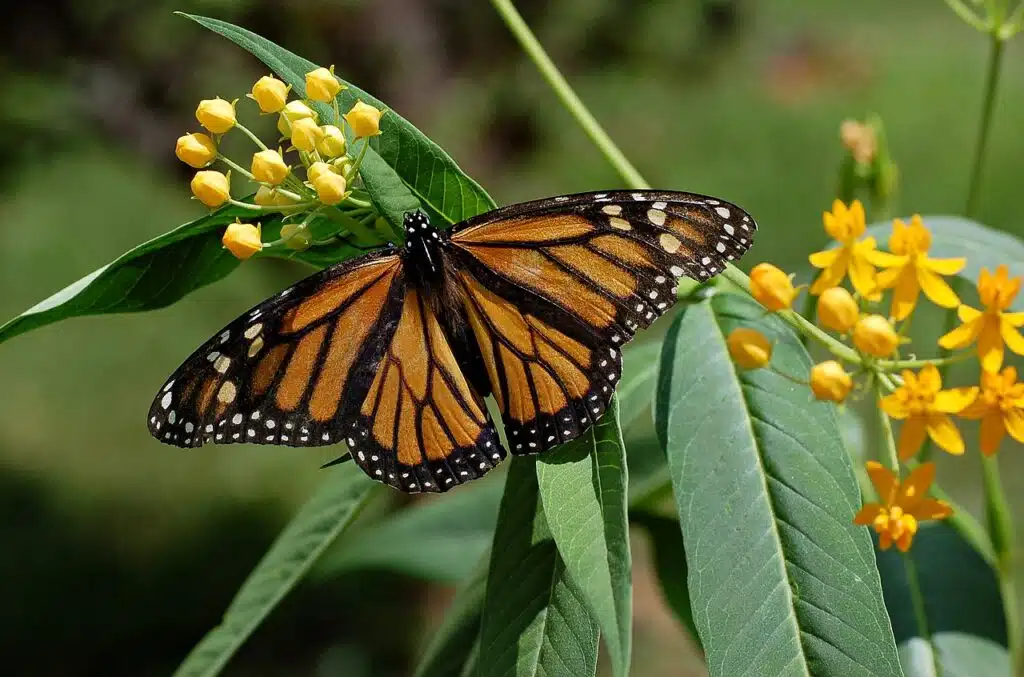
Monarch butterflies (Danaus plexippus) are some of the most common species in the state. They are seen both locally and passing by from Canada as they migrate to Florida in the fall.
Thousands of Monarch butterflies leave the state in the fall moving South. They only return to Pennsylvania as a new generation the following year once the winter is over.
These butterflies are identified by an orange base color with black veins and black margins.
The dark and pale orange coloring is specific to Monarchs depending on their gender.
2. Eastern Tiger Swallowtail
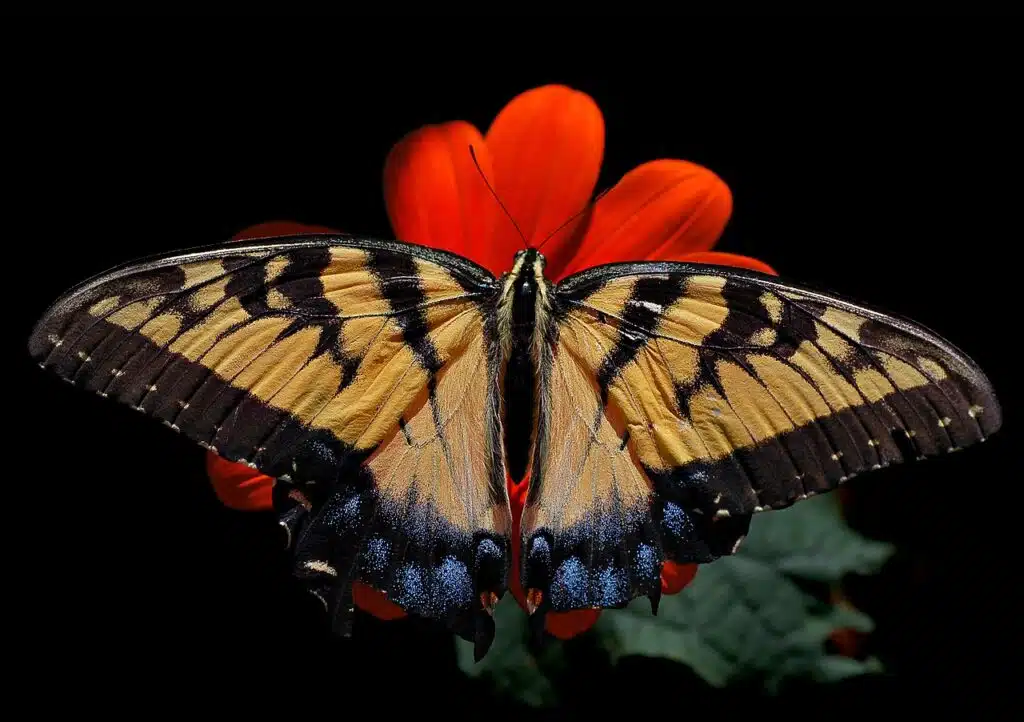
Eastern Tiger Swallowtails (Papilio glaucus) are common large butterflies in the state. These butterflies can reach a wingspan of more than 5 inches and they can be seen across the state.
A high flying altitude is specific to Eastern Tiger Swallowtails.
These butterflies can fly above trees which means they might not be as easy to spot as other diurnal species.
They can fly at lower altitudes whenever they mate as males and females court while flying.
Butterflies of this genus live on their own otherwise. They are sometimes seen on various red asters feeding on nectar.
3. Black Swallowtail
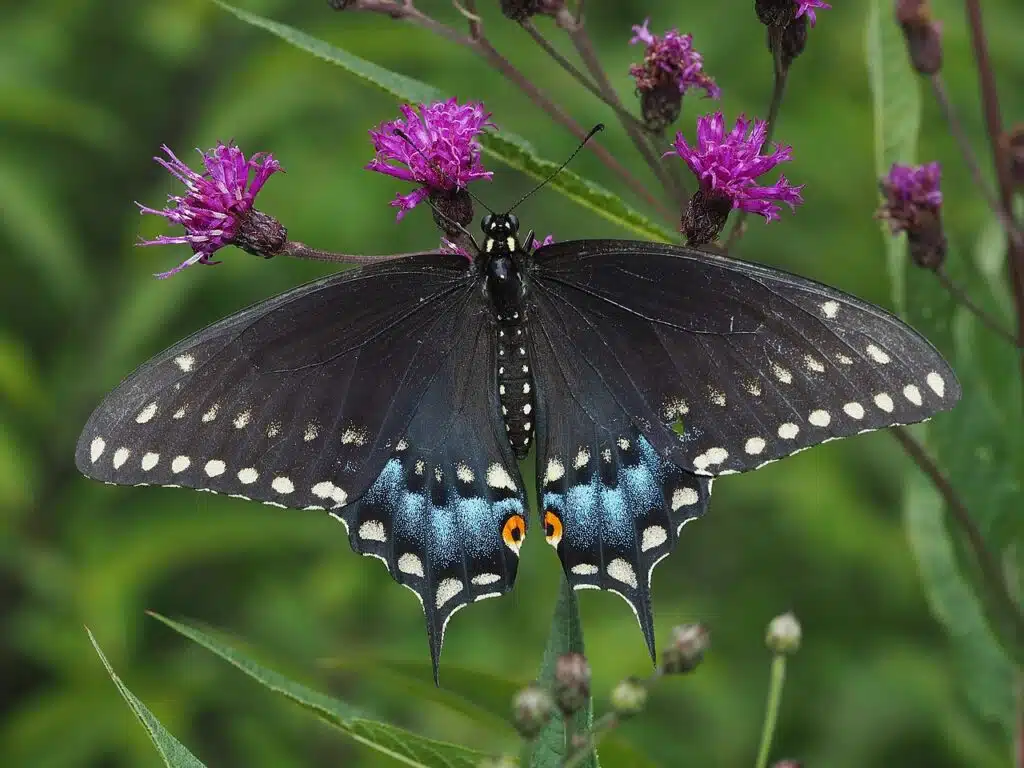
Black Swallowtails (Papilio polyxenes) are some of the most common species in the state that also mimic other butterflies.
It’s only the female Black Swallowtail that mimics other butterflies of the Pipevine Swallowtail genus.
Females how their wings more while laying eggs and they mimic foul-tasting butterflies to keep predators away.
Both male and female Black Swallowtails are primarily black.
Males have larger blue areas on the base of their hindwings. Both males and females have multiple rows of yellow dots.
4. Cabbage White
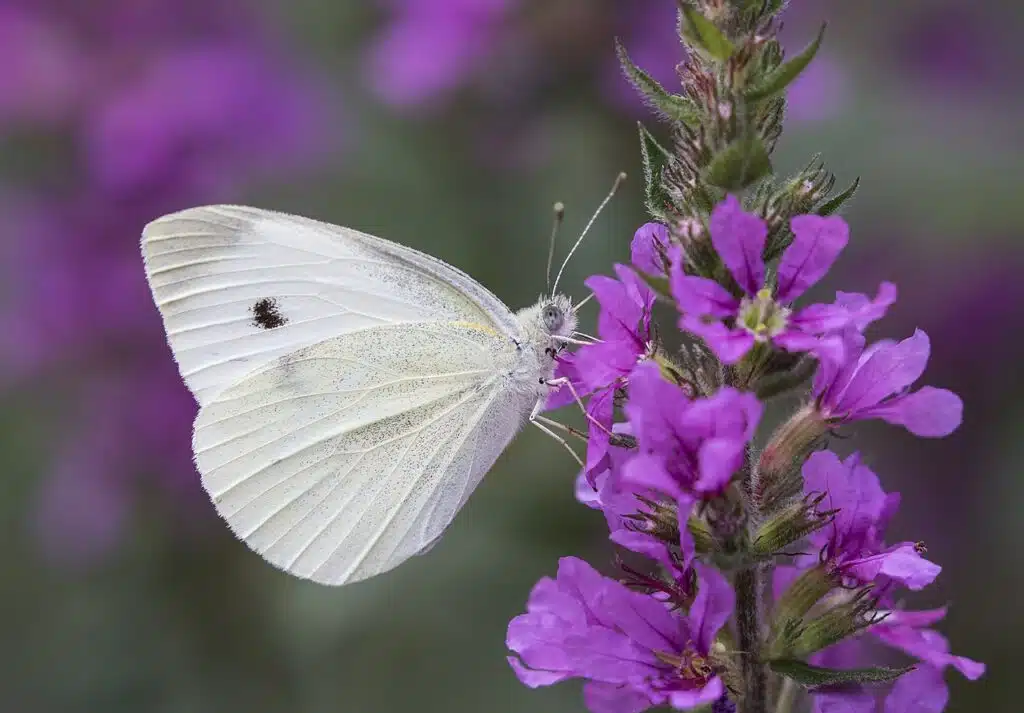
Almost completely white, the Cabbage White butterfly (Pieris rapae) gets its name from its favorite food, napa cabbage.
This butterfly eats different other species of flowers.
Cabbage White butterflies consume nectar after identifying it by color and smell.
Each stage in the life of this species is dominated by certain flowers that attract the species.
As an example, females prefer green flowers to lay eggs.
These green flowers are known to provide the right camouflage cover for the green larvae of Cabbage Whites.
5. Silver-spotted Skipper
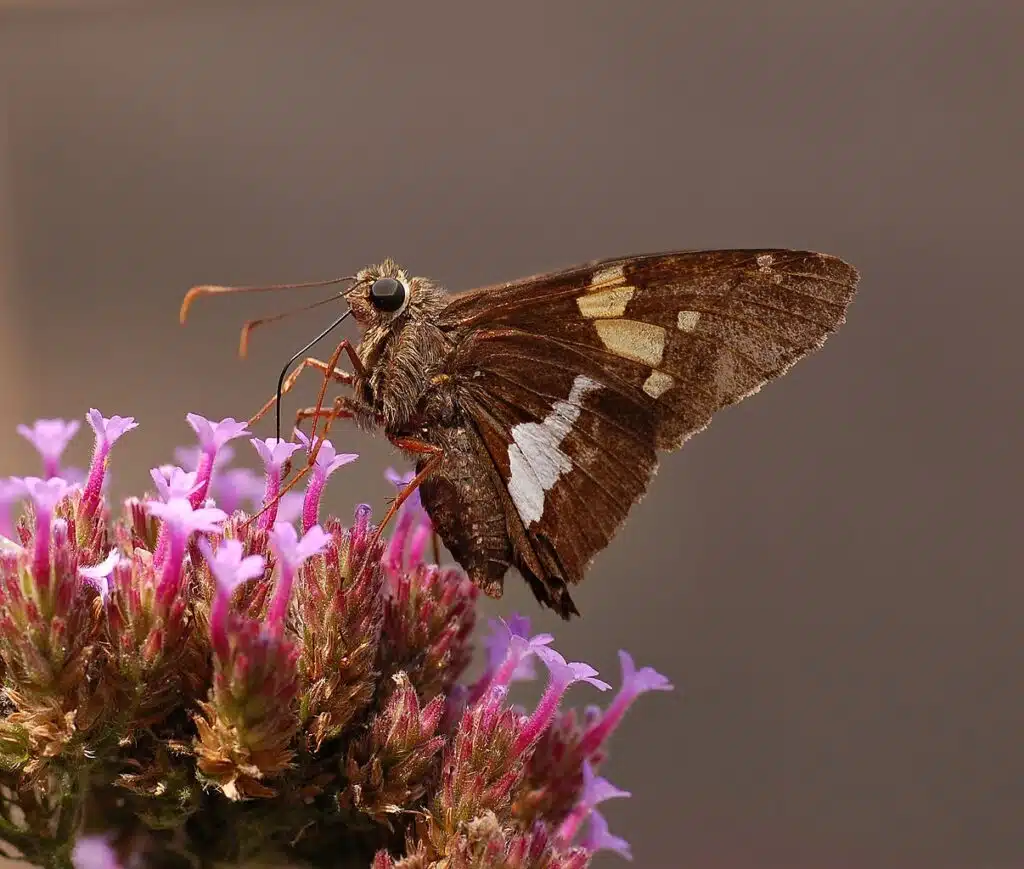
Silver-spotted Skippers (Epargyreus clarus) are some of the most common migratory species in the state.
These butterflies have a base brown color which allows them to escape unnoticed when meeting predators.
Its role in the ecosystem is considered detrimental as Silver-spotted Skippers don’t pollinate while consuming nectar.
They have adapted to piercing strategies that only gain nectar for them without pollination.
6. Red-spotted Admiral
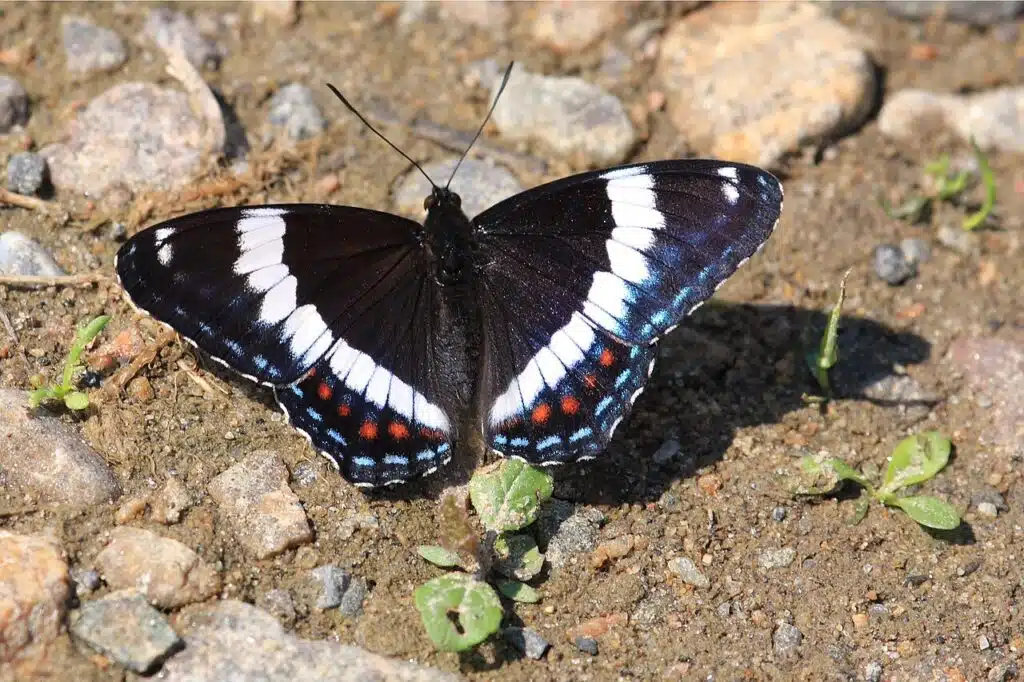
Red-spotted Admiral butterflies (Limenitis arthemis) are a species of black, blue, white, and orange butterflies.
This species is specific to the state and the North in general. Their range expands to the area of The Great Lakes.
Butterflies of this genus are known for having a combination of dark and light blue colors.
The ventral wings are mostly dark but they can also show blue and orange coloring.
You can find Red-spotted Admirals close to woodlands.
7. Spicebush Swallowtail
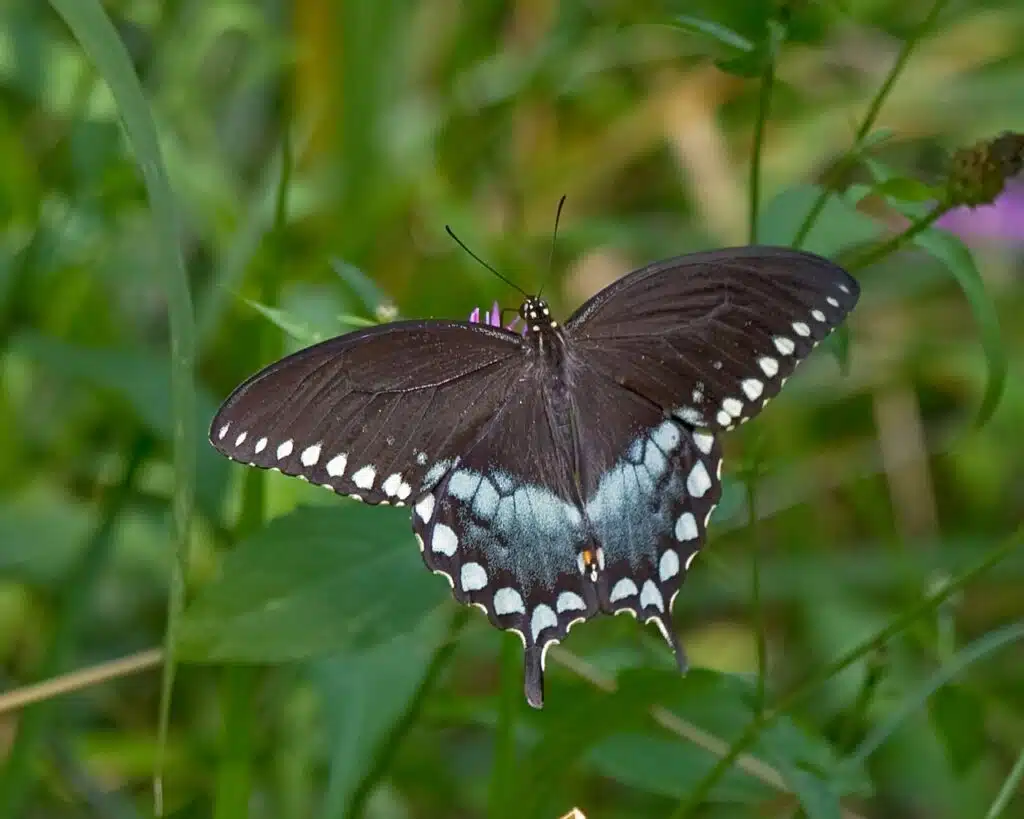
Also common around the edges of woodlands similarly to Red-Spotted Admirals, Spicebush Swallowtail butterflies (Papilio troilus) have mostly black wings.
The species has light blue to green lower hindwings.
Butterflies of this genus are also known for having multiple white spots across the edges of their wings.
This species may be seen up to early October or late September depending on the weather.
It represents one of the largest species in the state with a wingspan between 90 and 115mm.
8. Pearl Crescent
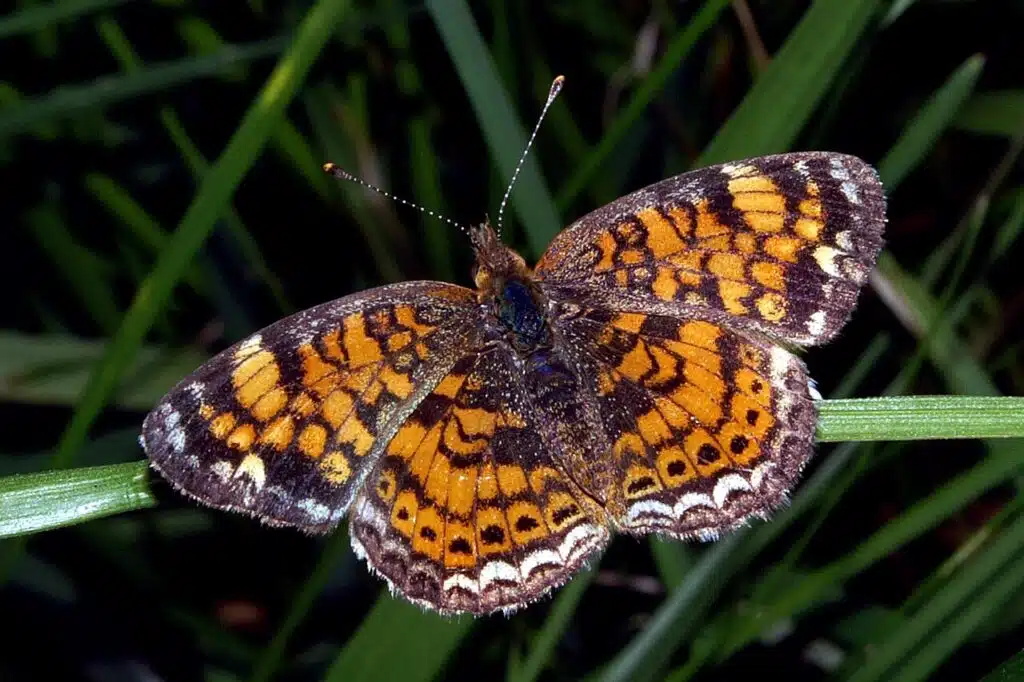
Dogbane and swamp milkweed are some of the preferred plants of Pearl Crescents (Phyciodes tharos). These butterflies are some of the most common in the North where they appear in April and fly to October.
Pearl Crescents don’t have a year-round flight season in Pennsylvania as in Sothern states.
The species is small to medium with an expected maximum size of up to 35mm.
Pearl Crescents have an orange to light brown color with black marks which are variable from one location o another.
9. Zabulon Skipper
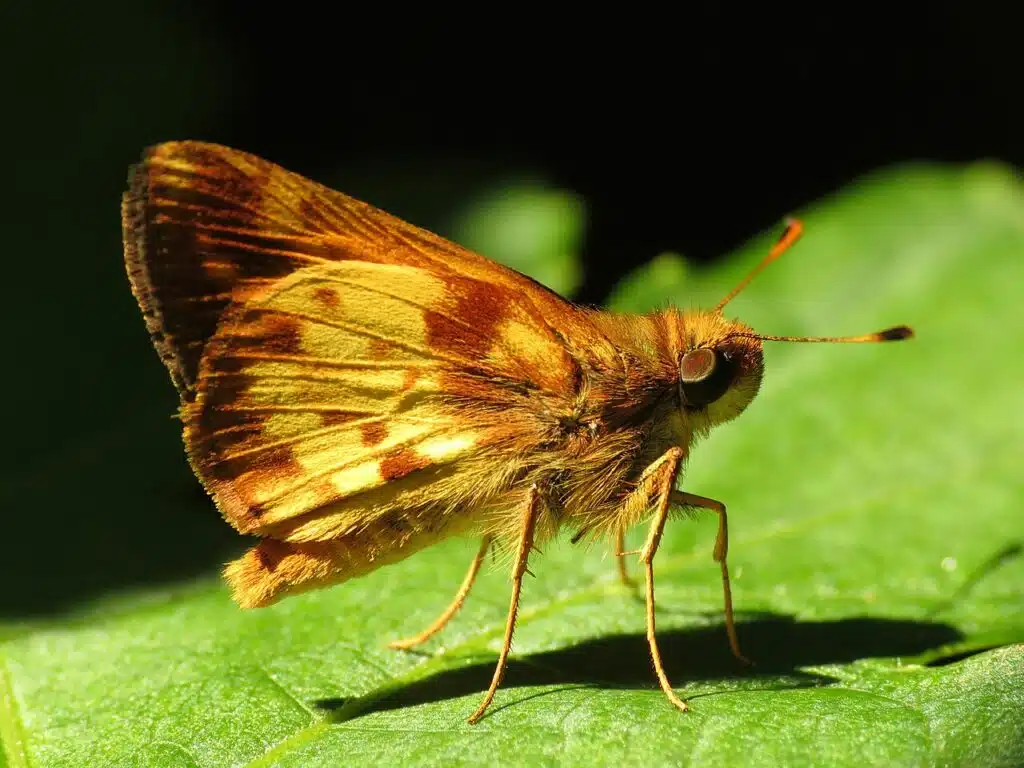
Zabulon Skippers (Lon zabulon) have a yellow base color with different nuances of brown. These butterflies tend to be small with an average wingspan of just over 1 inch.
Many Zabulon Skippers are found in Eastern US states including Pennsylvania.
These butterflies feed on all types of grasses and are a common sight next to roads or in gardens.
There are only 2 broods per year in the state.
You can expect to see the first Zabulon Skippers in the state in May. They continue flying until September.
10. Great Spangled Fritillary
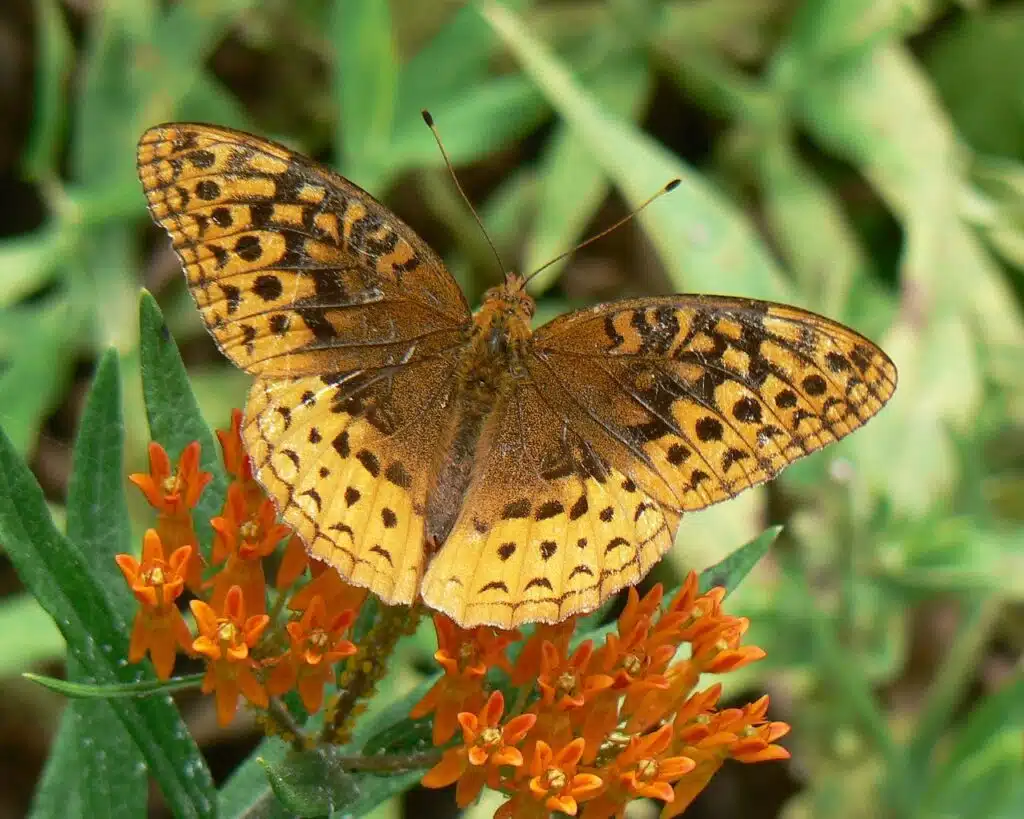
The Common Blue Violet is one of the species the Great Spangled Fritillary butterfly (Speyeria cybele) can be seen around. Its caterpillars use different species of violet as host plants.
The species is known for having a medium to large size. Its wingspan measures at least 68mm and it may reach a length of up to 88mm.
Great Spangled Fritillary butterflies are characterized by brown base coloring across the forewings and tan to yellow coloring on the lower hindwings.
11. Sachem
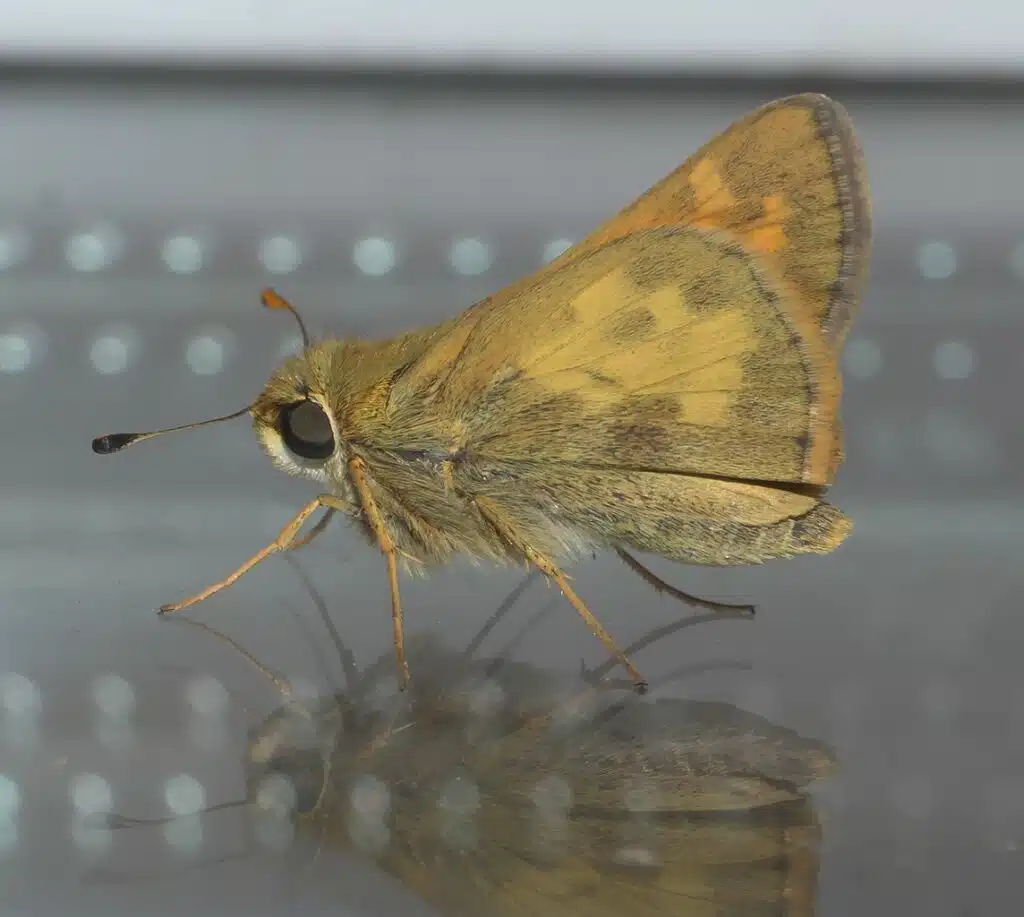
Sachem butterflies (Atalopedes campestris) are true skippers. These butterflies are seen on meadows, in parks, and around the house.
They feed on various types of grasses. Bermuda grass and St. Augustine grass are among their favorite species.
Sachem butterflies have a wingspan of up to 41mm.
Small and colorful, the species has a combination of various shades of brown and yellow. It folds its forewings to form a triangular shape.
Its caterpillars are mostly dark green or olive green. The caterpillars also have black heads.
12. Red Admiral
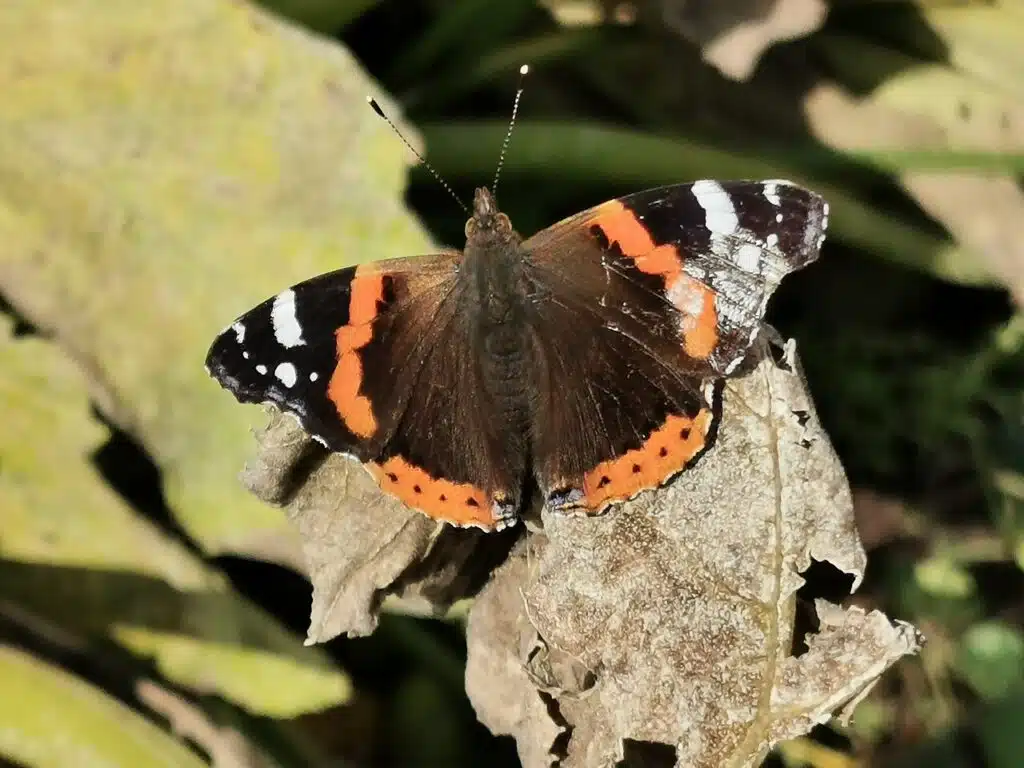
Red Admirals (Vanessa atalanta) are migratory species that impress with their size and the length of their journey.
They make their way back to the state in the spring flying in together with thousands of other butterflies.
Red Admirals are mostly black. They also show orange-red and white coloring in the form of bands. Orange margins with tiny black dots are also seen on its lower hindwings.
This species has a medium to large size. The smallest Red Admiral measures around 62mm in wingspan but the species can grow to more than 70mm.
13. Peck’s Skipper
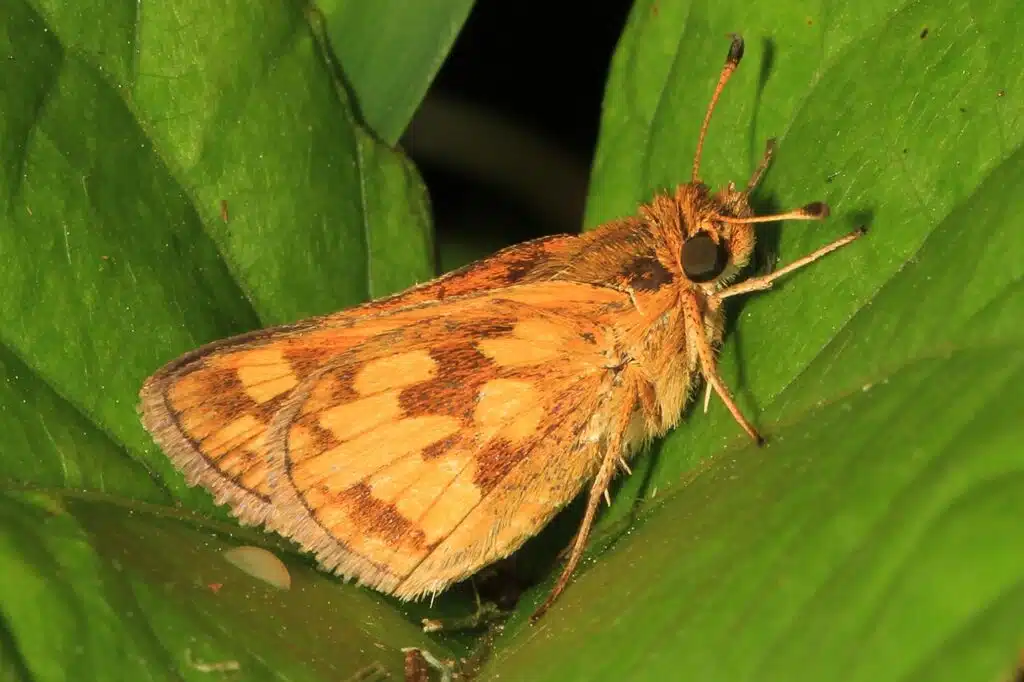
This species of skipper (Polites peckius) is found throughout the state.
Peck’s Skippers are a small species that are known for their multiple nuances of brown or maroon colors.
These butterflies can also fold their forewings.
Peck’s Skippers eat different types of grasses. These are decorated grasses or wild grasses.
The species can also be a mild pest on clover and sunflower crops. Its damages are small and not of considerable economic importance.
Multiple broods of Peck’s Skippers are seen from May to October in the state.
14. Eastern Tailed-Blue
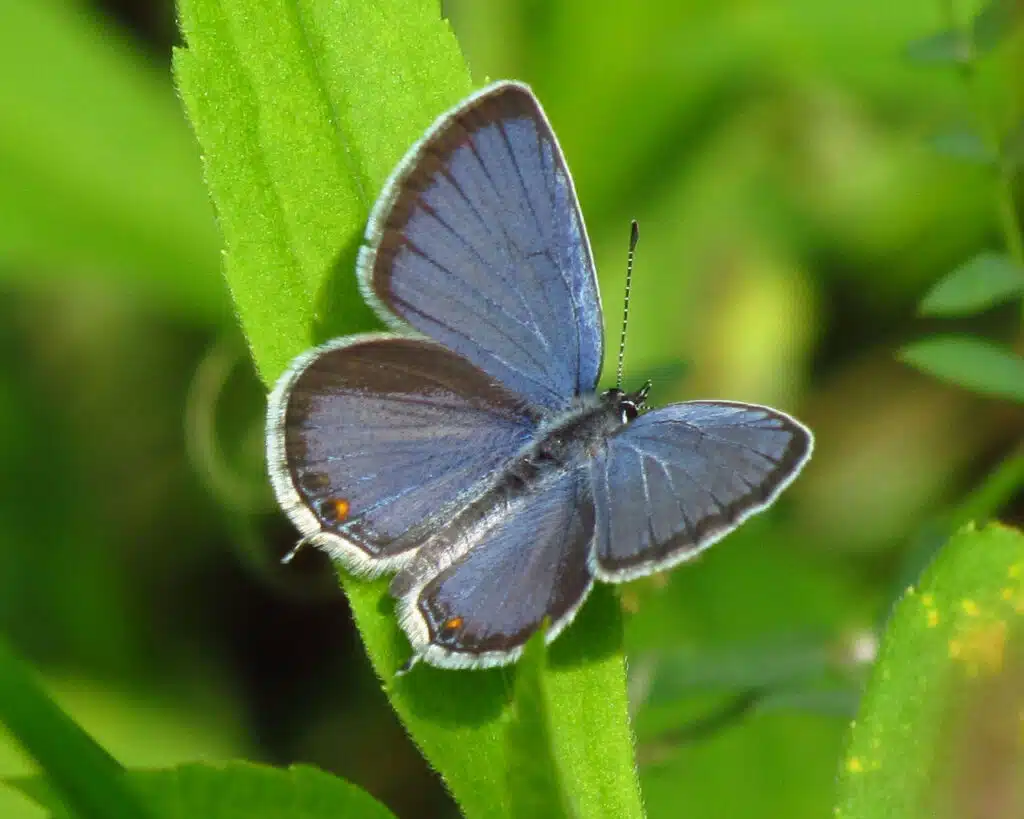
This butterfly (Cupido comyntas) is common across the state and other states in Eastern North America.
Blue and gray are common colors of the species. Males have a light gray to blue color while females have a mostly black color with orange spots on the lower hindwings.
Butterflies of this genus have contrasting margins on the wings. Males have black and white margins while females only have white margins.
You can find these types of butterflies and their caterpillars around clovers they feed on.
15. Eastern Comma
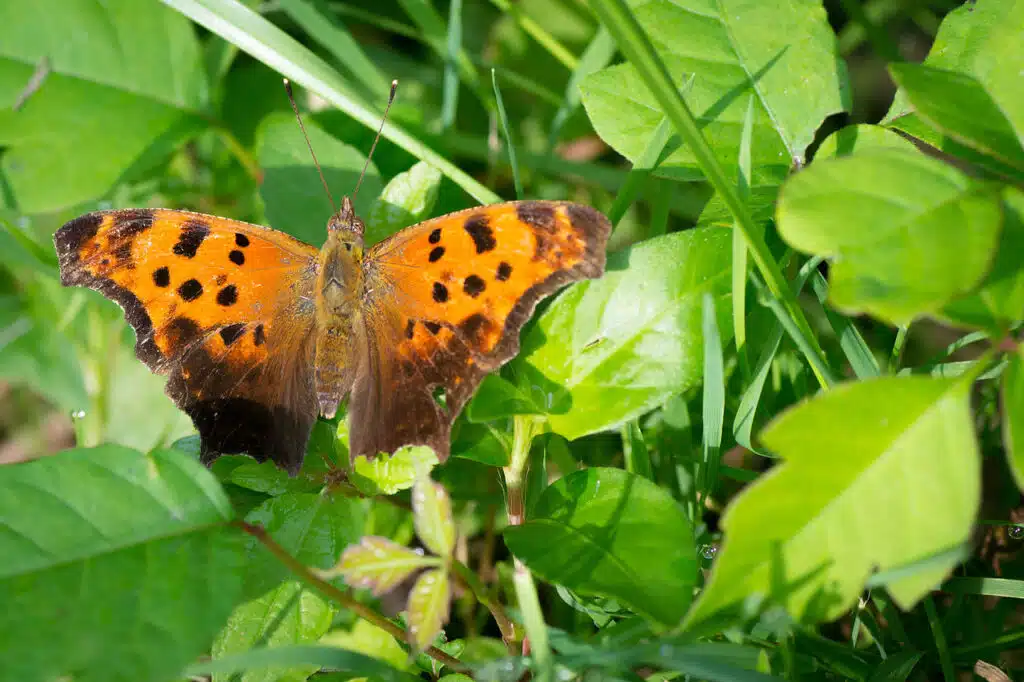
Nettle and false nettle are among the most common host species for the caterpillars of Eastern Commas (Polygonia comma).
These are the host of the caterpillar and together with American elm, they provide food for the growing larvae of the species.
Once an adult, Eastern Comma butterflies don’t feed on these plants anymore.
Rotting fruit and minerals from water and mud are preferred by the adult Eastern Comma.
The species has an orange-brown base color with dark brown patterns that show a variable profile.
16. Common Buckeye
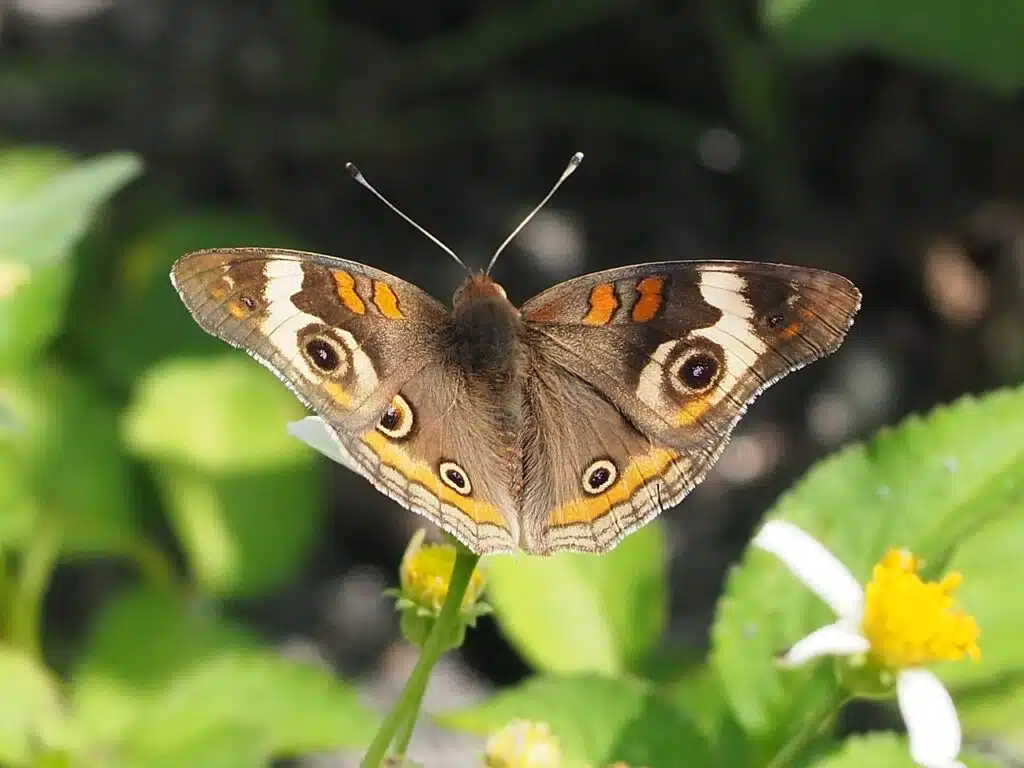
Common Buckeyes (Junonia coenia) are some of the most prevalent migratory species in the state.
They begin flying South in September. All butterflies of this species leave the state by late October when cold air moves in.
Common Buckeye butterflies have a base brown color and are also known for having multiple large eyespots that keep predators away.
Light brown coloring also displaying contrasting eyespots is specific to the ventral wings of the species.
17. Orange Sulphur
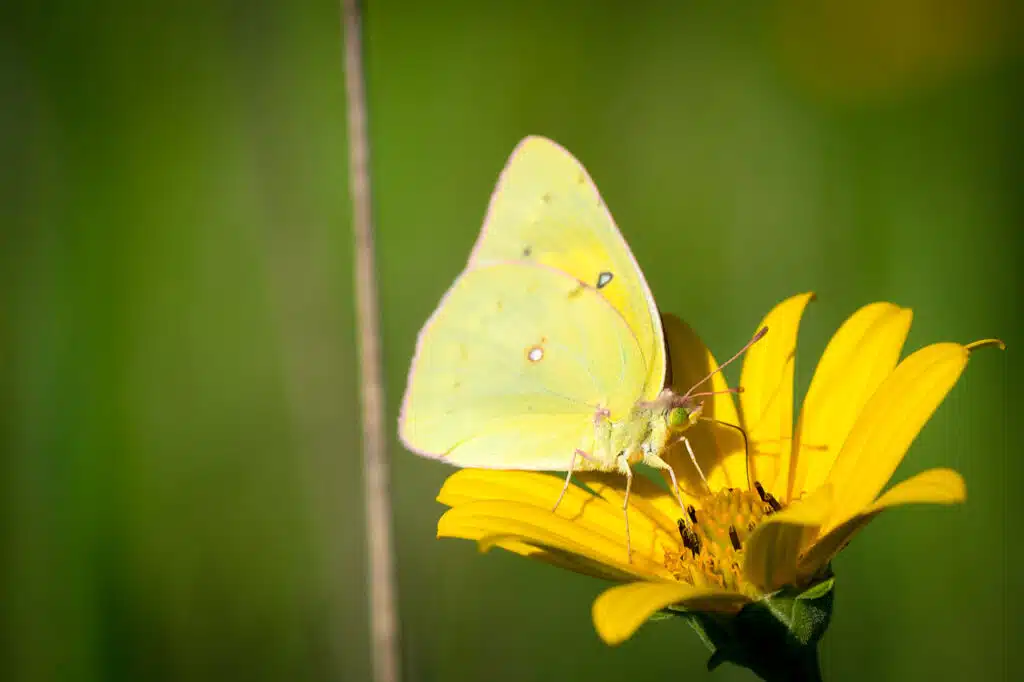
Orange Sulphur butterflies (Colias eurytheme) are found on alfalfa crops. This species is a minor pest to alfalfa as well as to other pea family plants.
It has a base orange color with wide black margins.
The ventral color of the species is either yellow or light green which helps it look more like a colored leaf when on crops.
You may not see this species easily during the day. Orange Sulphur caterpillars only come out at night.
18. Summer Azure
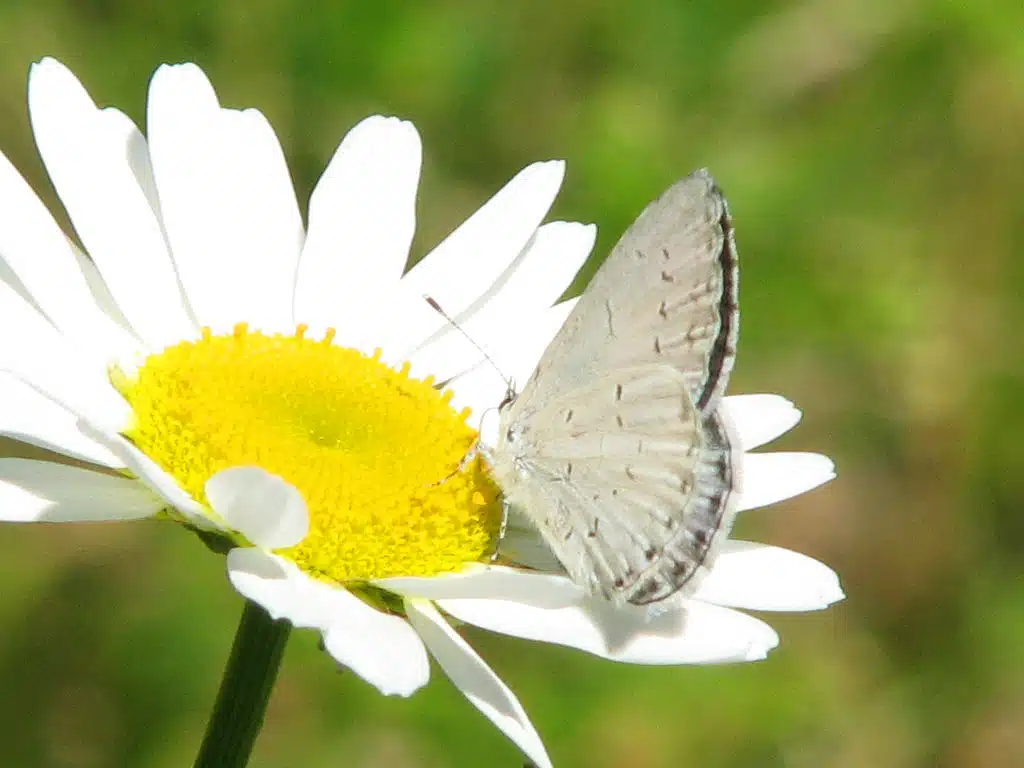
Summer Azure butterflies (Celastrina neglecta) are small and characterized by pale colors and white coloring.
This species grows to a maximum wingspan of up to 19mm.
It has light blue coloring on the wings that turn gradient and white towards the margins.
The margins of the wings are black.
This species of butterfly has a white or light brown ventral color. Its ventral wings are decorated with tiny black marks.
You can see these butterflies in the state in the summer. They tend to appear in June.
19. Wild Indigo Duskywing
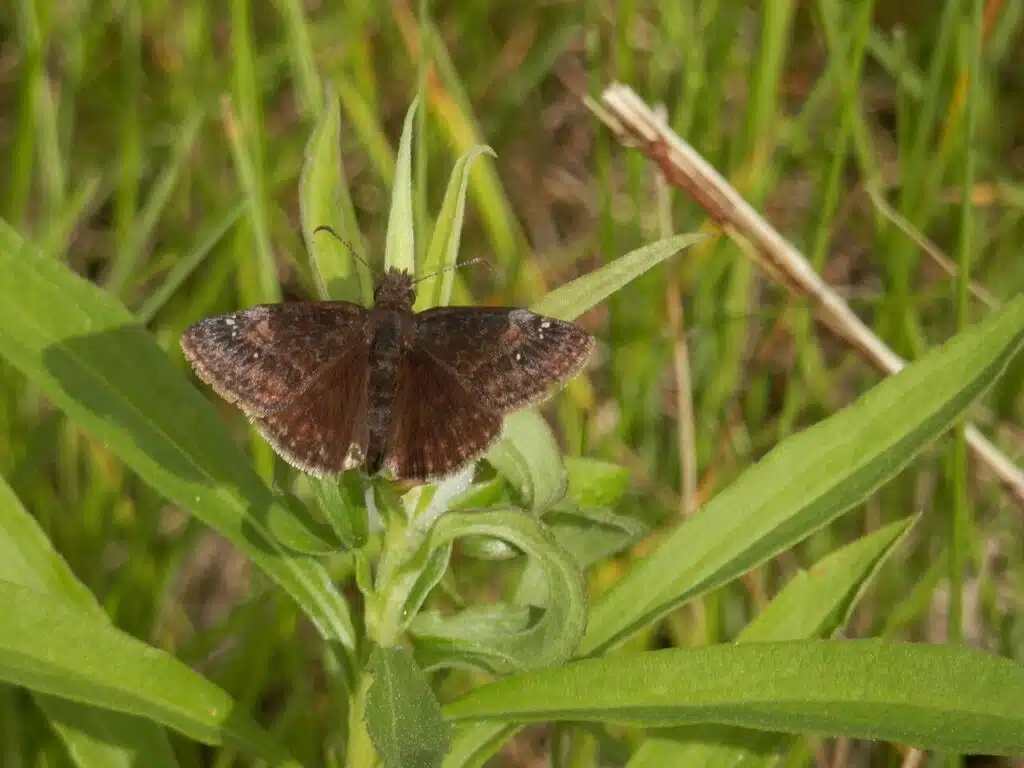
This species of butterfly (Erynnis baptisiae) is known for feeding on various plants rich in nectar.
It prefers many types of clovers such as crimson clovers. It also feeds on berries.
This species is identified by its brown colors across its dorsal wings.
There’s no indigo color on the dorsal wings of the Wild Indigo Duskywing.
This species is seen in 2 broods in the state. The first brood is seen in Pennsylvania in April.
20. Meadow Fritillary
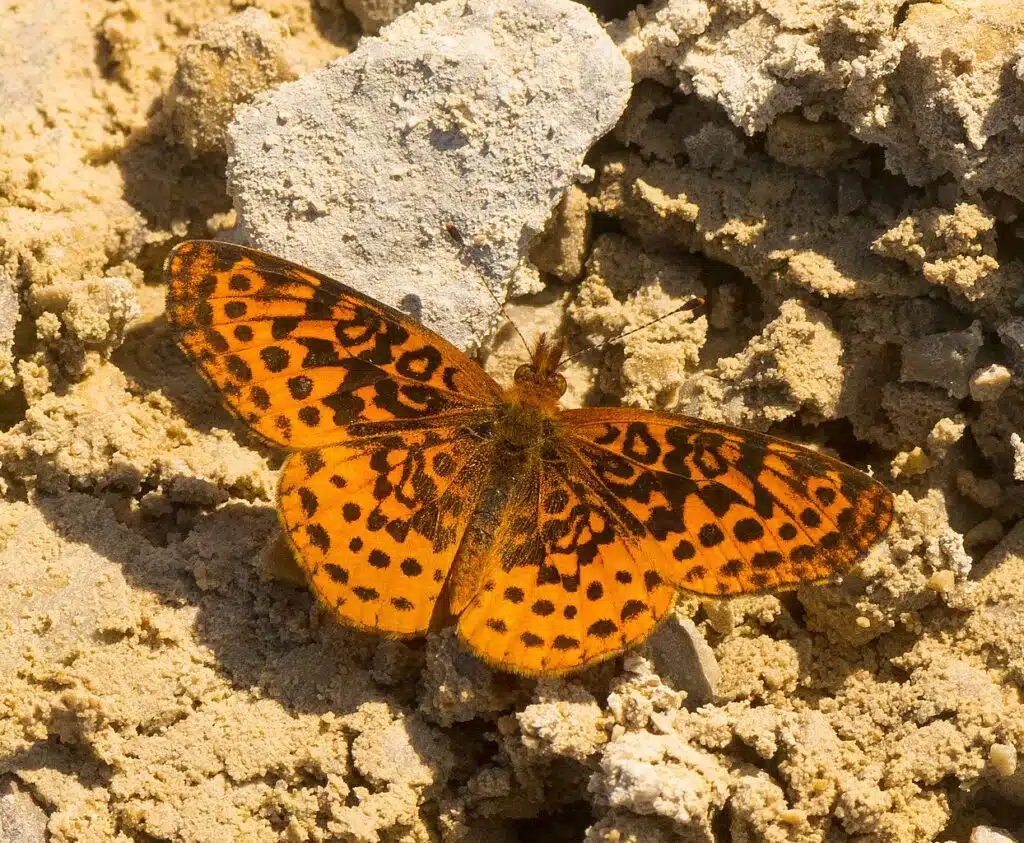
Meadow Fritillary butterflies (Boloria bellona) have a mostly yellow and orange color with dark brown sections.
They also show tiny black decorative spots.
These colorful butterflies start life as green spherical eggs.
You can find these types of butterflies in wet habitats across the state, particularly in open areas.
21. Question Mark
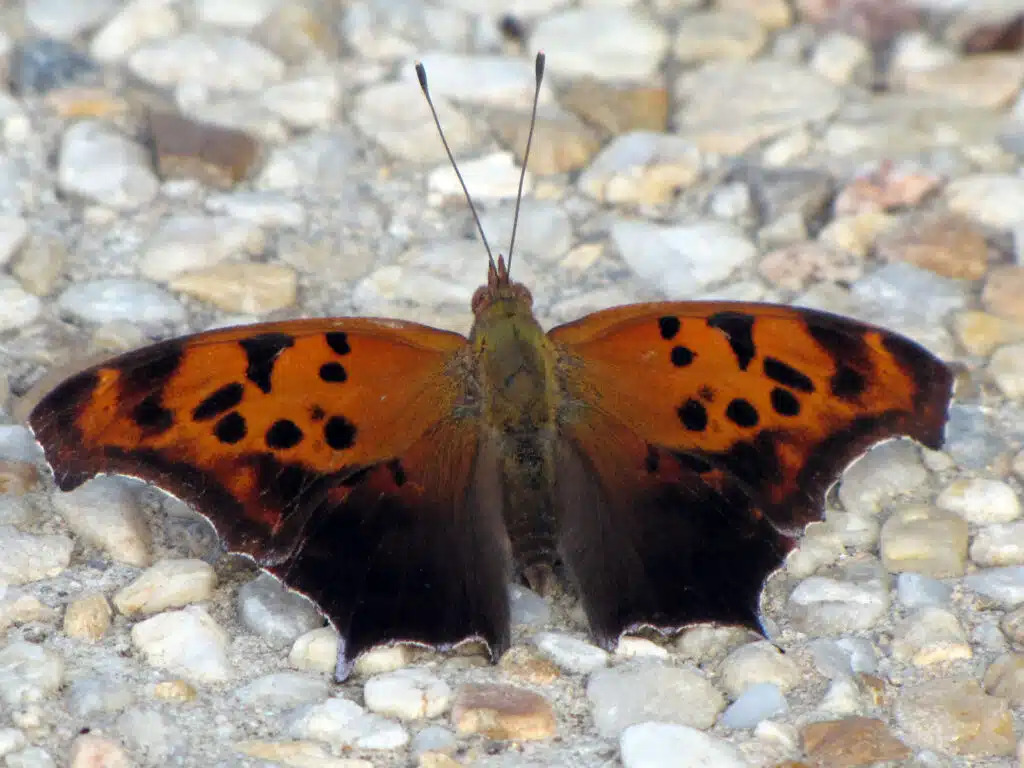
Question Mark butterflies (Polygonia interrogationis) have orange and brown coloring with black spots across the wings.
This species of butterfly has ventral coloring that resembles the appearance of tree bark.
Question Mark butterflies are among the few species that lay eggs under leaves on the ground and not on host plants.
Survival rates for emerging larvae are low.
22. Variegated Fritillary
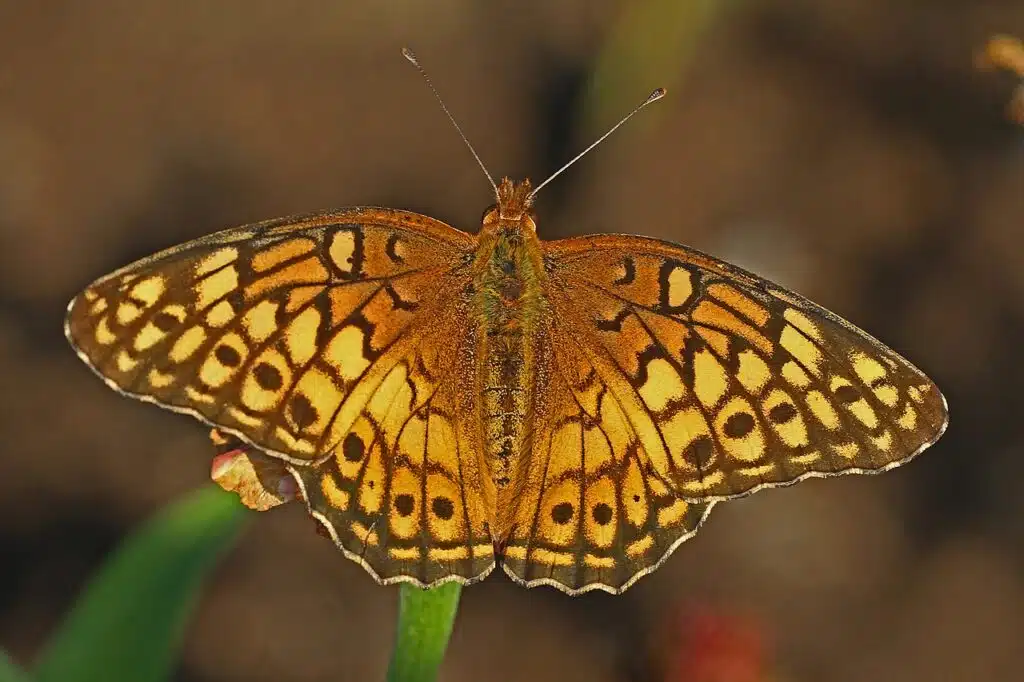
Passionflowers and violets are among the common hosts of the Variegated Fritillary (Euptoieta claudia). Butterflies of this family appear in June across the state.
Variegated Fritillary butterflies have light brown, dark brown, and orange coloring with black marks across the wings.
The species has a black body.
It grows to a wingspan of up to 2.2 inches.
23. Little Wood Satyr
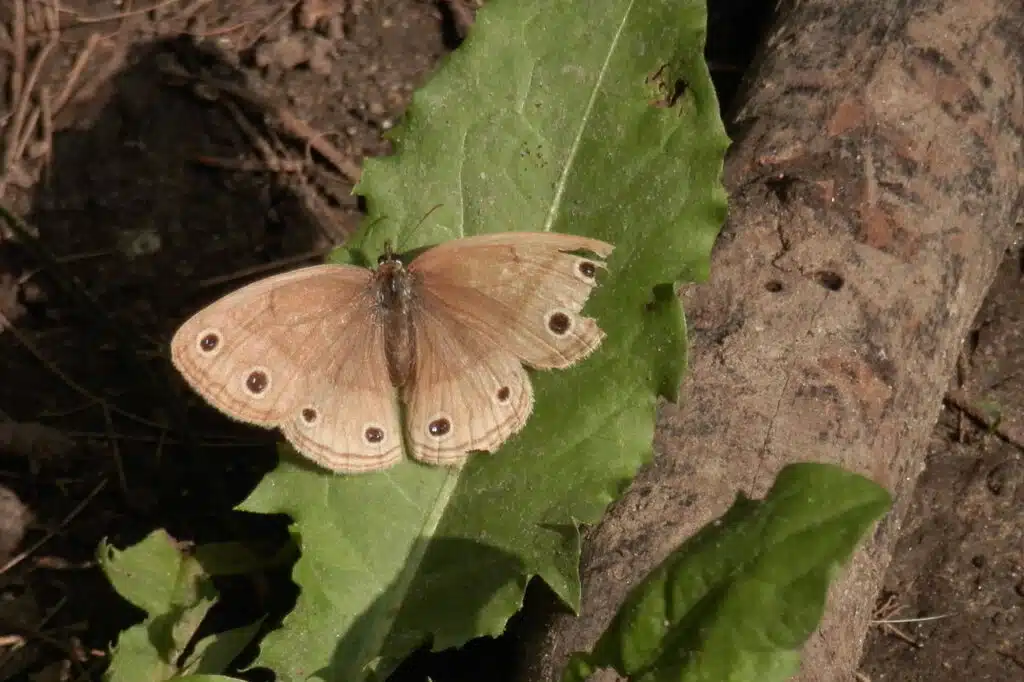
Little Wood Satyr butterflies (Megisto cymela) are seen around their host plants. These plants are orchard grass and centipede grass.
Dominated by light brown color, Little Wood Satyr butterflies have dark brown to black eyespots across the wings.
Black and yellow eyespots are also seen on the bright ventral wings.
24. Mourning Cloak
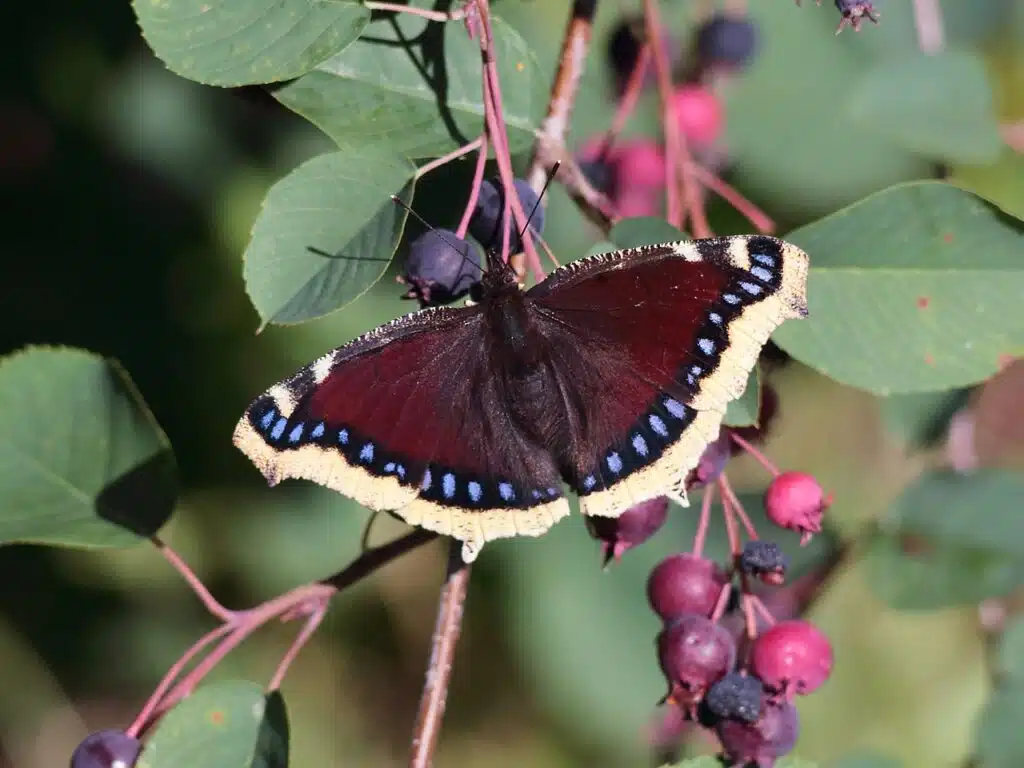
Mourning Cloak butterflies (Nymphalis antiopa) are adapted to the cold months of the North.
This butterfly species has a base brown color with wide yellow margins. Multiple tiny blue dots are seen on the brown areas close to its yellow margins.
These butterflies look completely different from other species in the state and they also live the longest.
25. Least Skipper
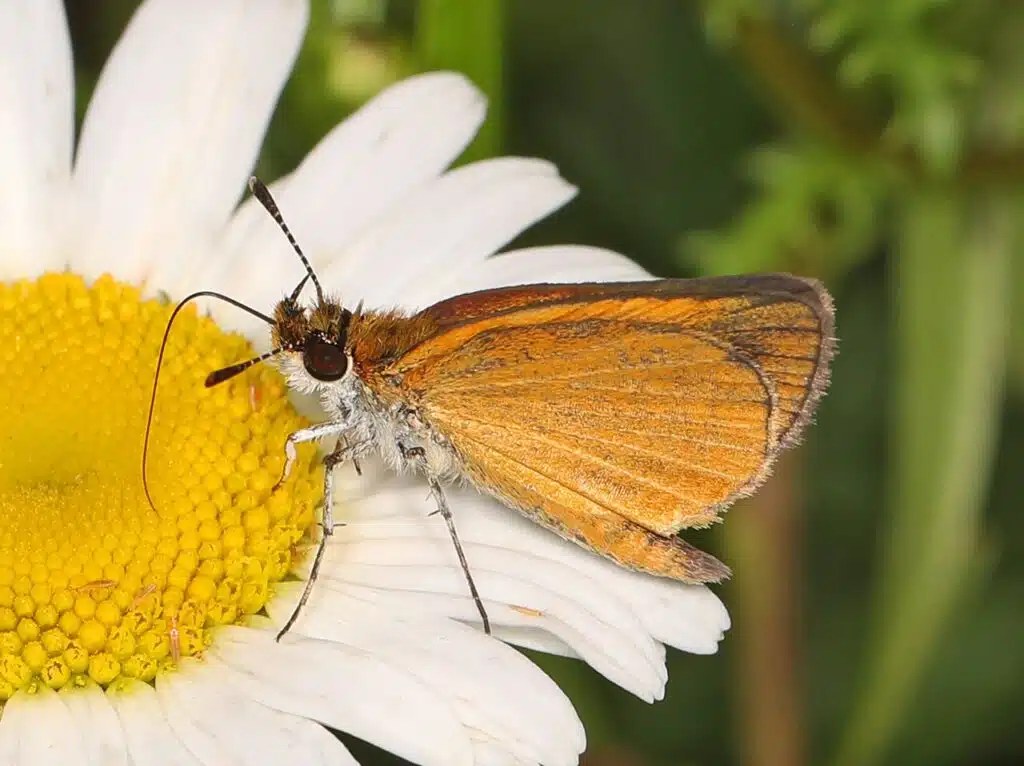
This species of yellow and dark brown butterfly (Ancyloxypha numitor) is seen across the state from May to September.
You can find it in various damp habitats such as swamps, ditches, or riparian areas next to lakes and rivers.
The species prefers tall grasses and it’s unlikely you’ll see it on your frequently-watered lawn.
Pale yellow eggs are laid directly on the tall grasses in their favorite habitats.
26. Painted Lady
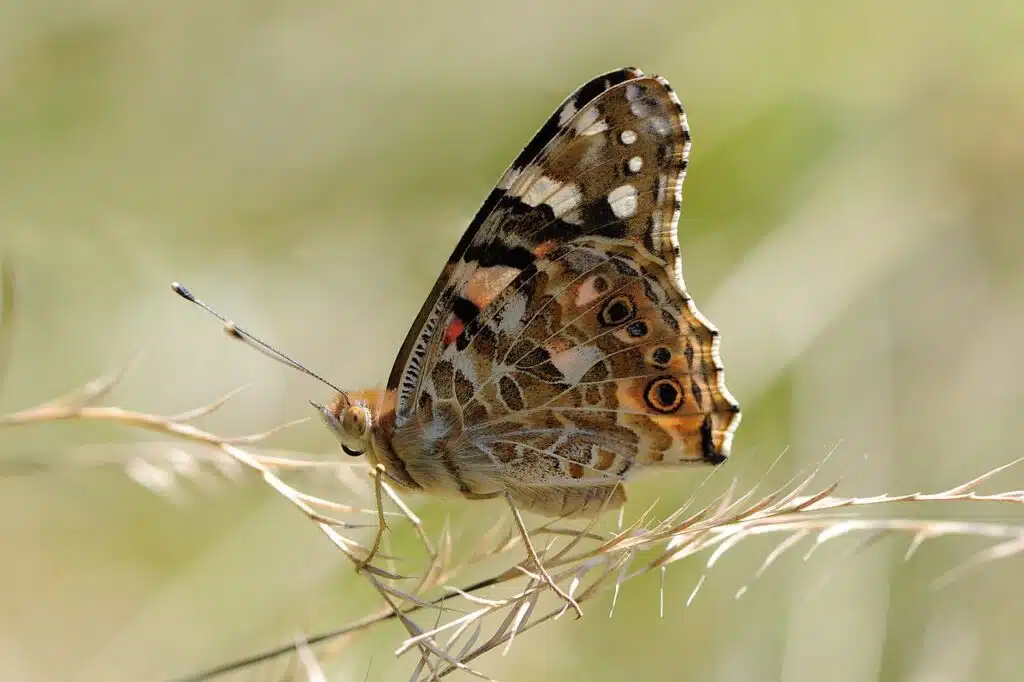
Painted Lady butterflies (Vanessa cardui) are some of the most common migratory species in the world also present statewide.
You can identify this species by its orange color with black and white color combinations.
The ventral side of the species is similar to a puzzle made from black, orange, white, brown, and dark brown patterns.
These butterflies lay green eggs on the leaves of their host plants.
27. Hackberry Emperor
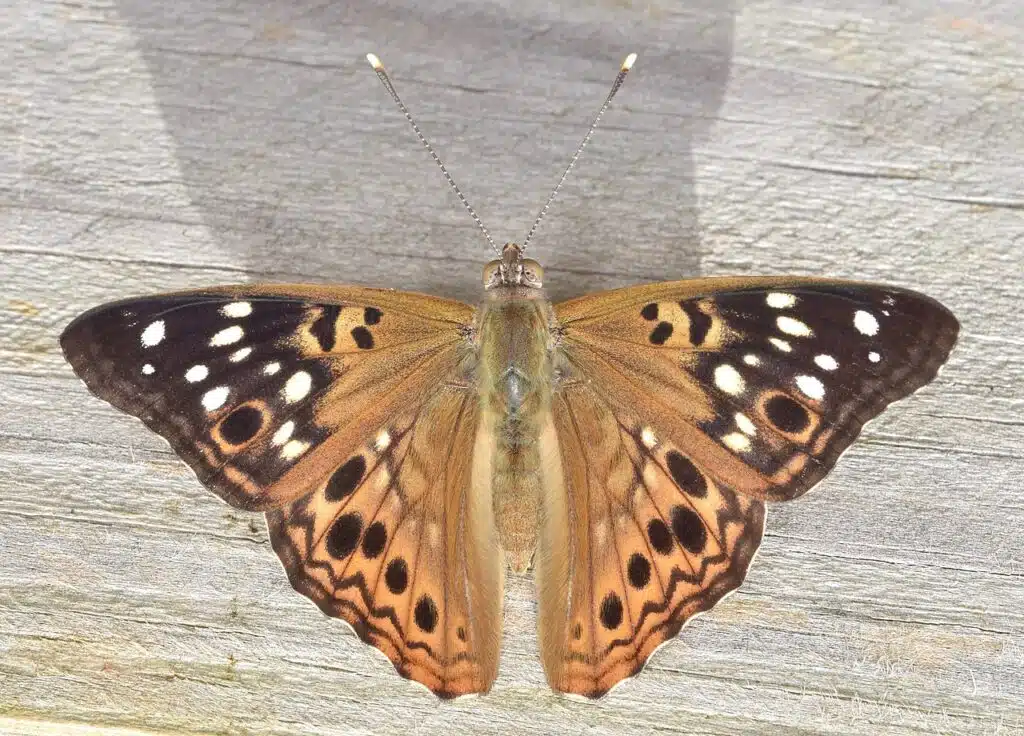
Hackberry Emperor butterflies (Asterocampa celtis) have a dark brown and brown color combination across their wings.
Darker nuances are specific to its forewings.
White dots also decorate the forewings of the species.
Hackberry Emperor caterpillars feed on the leaves of hackberries and other trees.
Adults prefer hackberry sap. They might also eat carrion such as dead snakes or dead rats.
These butterflies aren’t known for eating flower nectar.
28. Northern Pearly-Eye
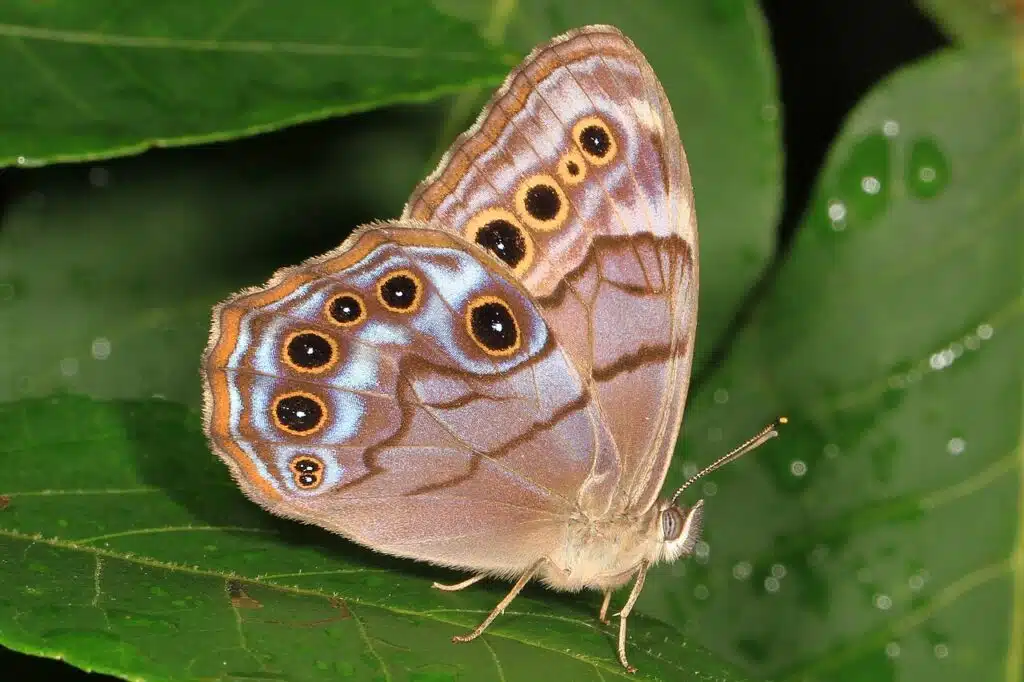
This type of butterfly (Lethe anthedon) is tied to Northern territories where it feeds on grasses such as false metallic grass.
Some of these grasses are used as decoration in parks and gardens which makes the species a common sight here.
You can identify the species by its gray-brown color with dark brown eyespots.
Butterflies of this genus have light brown and white coloring on the ventral wings. Eyespots are also seen on its ventral wings.
29. American Lady
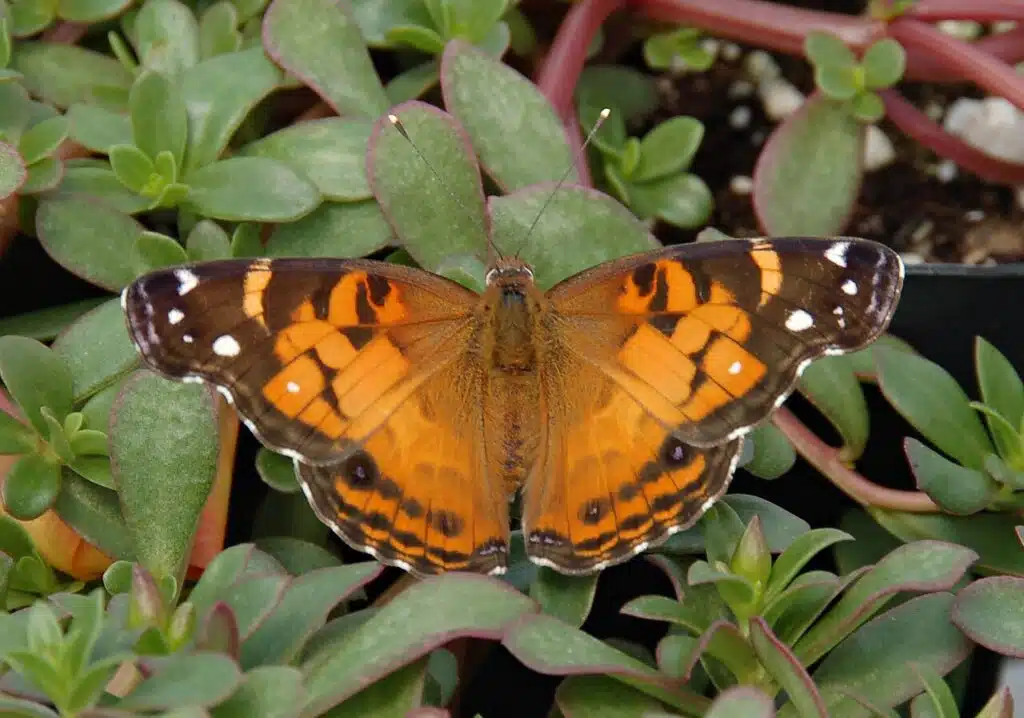
Orange and black on the dorsal wings, American Lady butterflies (Vanessa virginiensis) are seen all across the state.
Their complex diet which involves consuming nectar from some of the most common flowers makes them a common sight in many areas.
These butterflies feed on most asters and most types of dogbane.
The species has a small wingspan that barely measures more than 1 inch. You can identify it by the bright red band seen across its ventral wings.
30. Clouded Sulphur
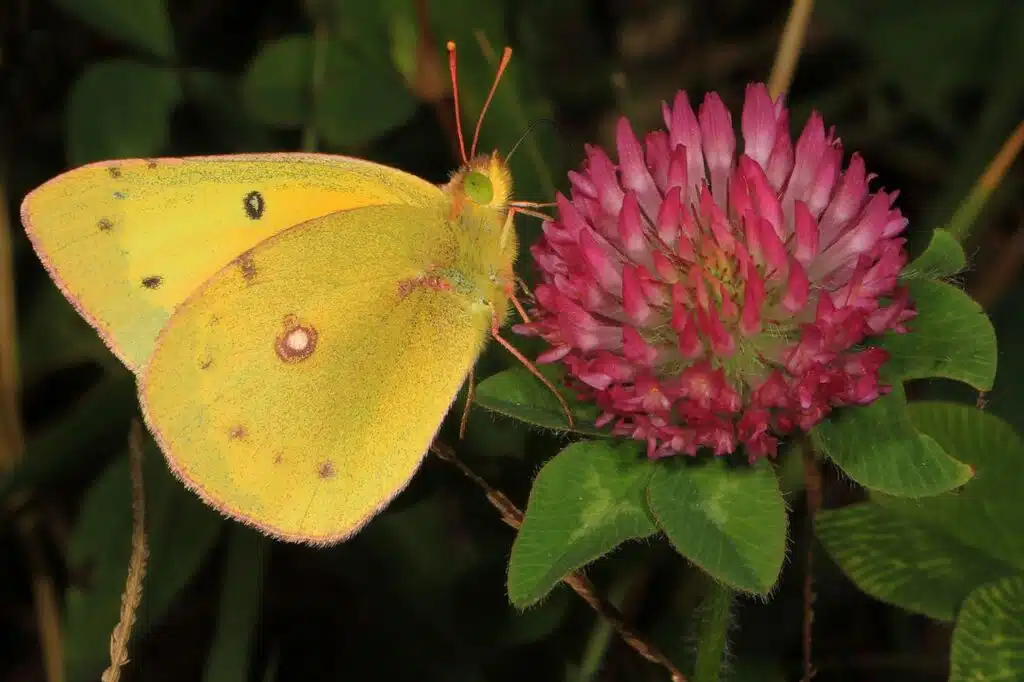
Male Clouded Sulphurs (Colias philodice) are dominated by a pale yellow color while females almost appear white.
These butterflies feed on multiple types of flowers that are rich in nectar.
Their preferred plants are also the preferred plants of other species. They include milkweed and butterfly bush.
Clouded Sulphur caterpillars are pests of clover and soybean.
31. Red-banded Hairstreak
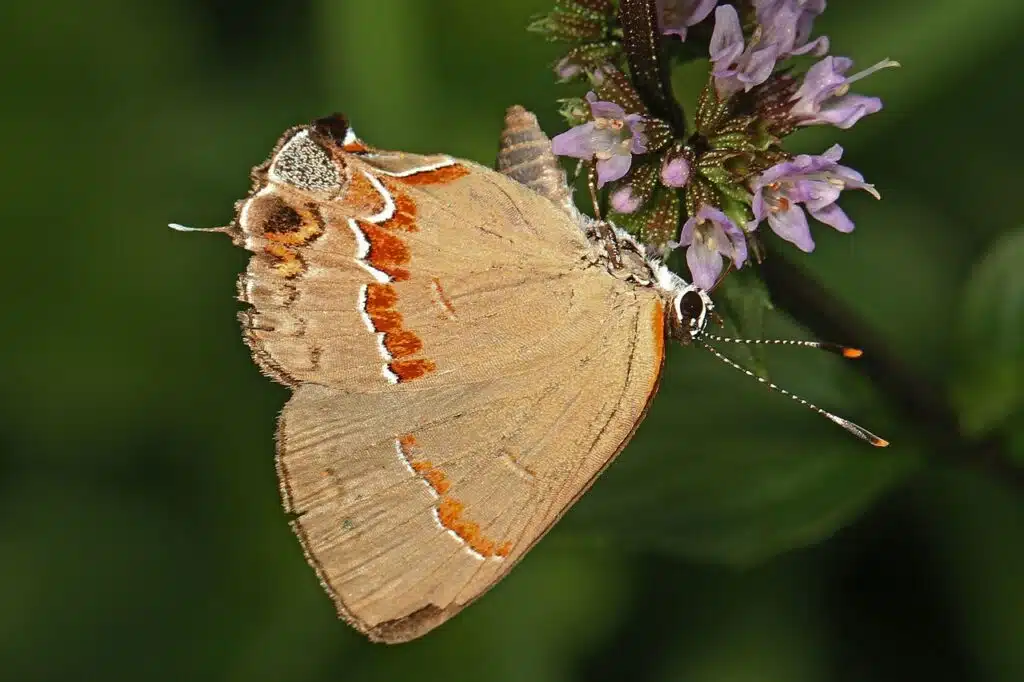
Red-banded Hairstreak butterflies (Calycopis cecrops) are seen as strays in Pennsylvania.
This species is identified by the orange or red band that runs across its dorsal forewings.
Red-banded Hairstreak butterflies aren’t as common in Pennsylvania as in the Southern states.
32. Gray Hairstreak
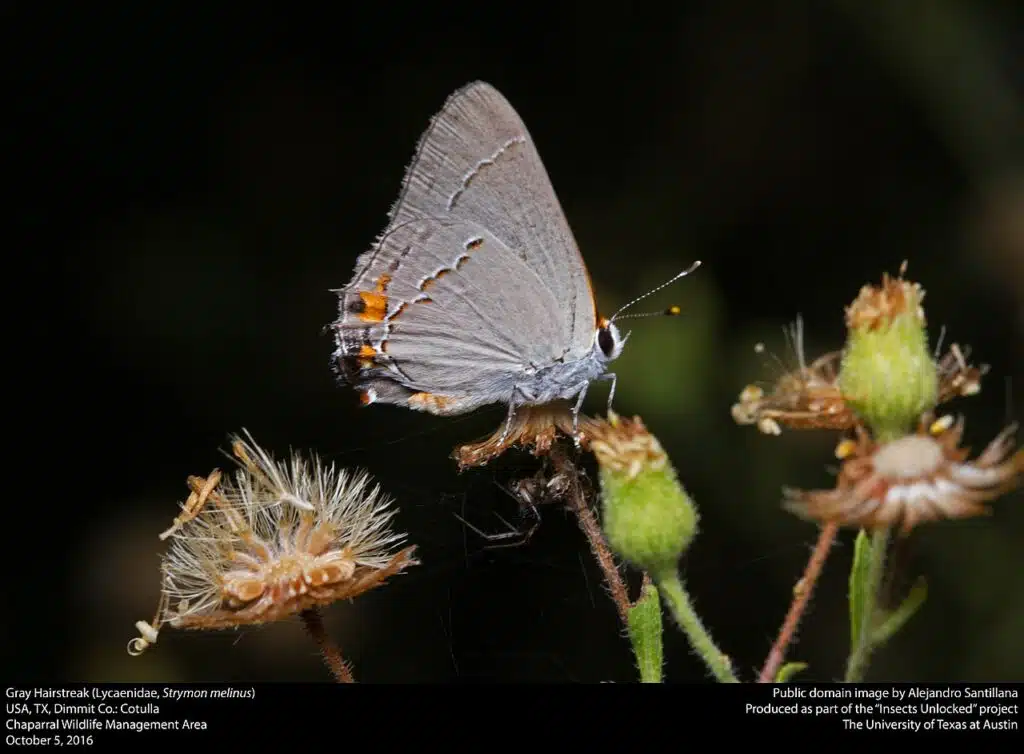
This species (Strymon melinus) of gray and blue butterflies is one of the common pests on clover across the state.
White clover and white sweet clover are some of the most common plants these butterflies feed on together with other butterflies and bees.
You can find these butterflies in areas near woodlands. They prefer high-altitude woodlands.
33. Viceroy
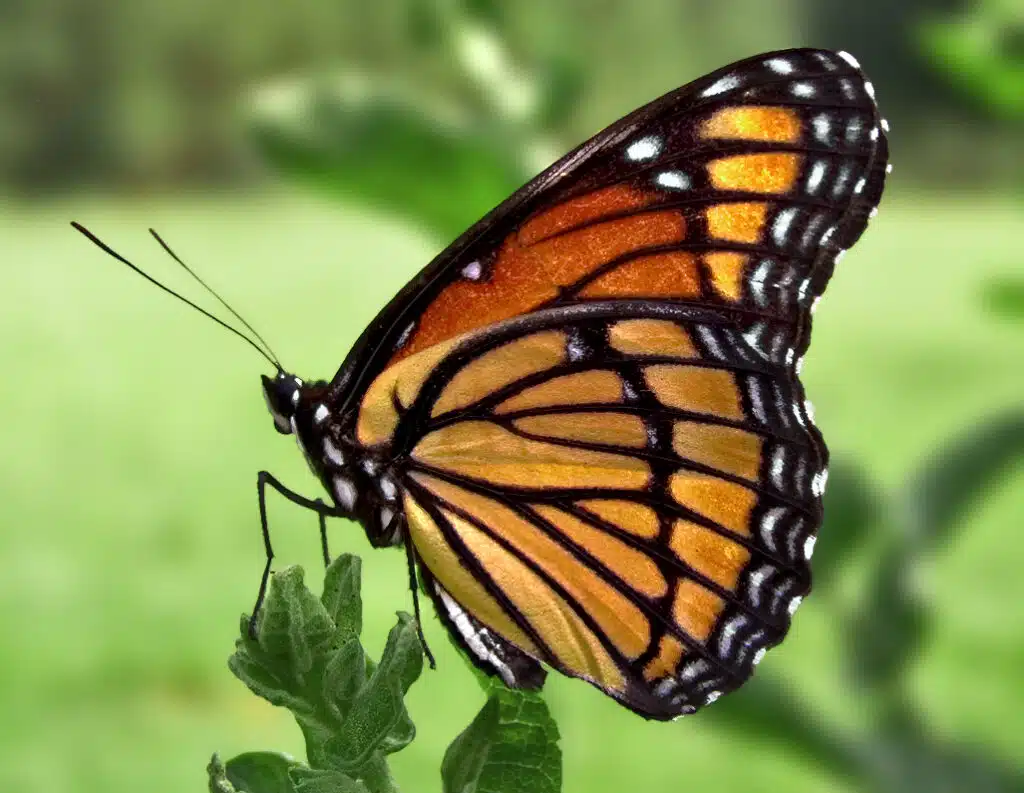
Viceroy butterflies (Limenitis archippus) are sometimes confused with Monarch butterflies based on their orange and black coloring.
These butterflies are found all across the state, especially on hardwood trees.
Willows are a common species that are a host for Viceroy caterpillars.
Poplars are another common host for the species.
Viceroy caterpillars extract toxins from the leaves of these trees to have a bad taste for predators.
34. Silvery Checkerspot
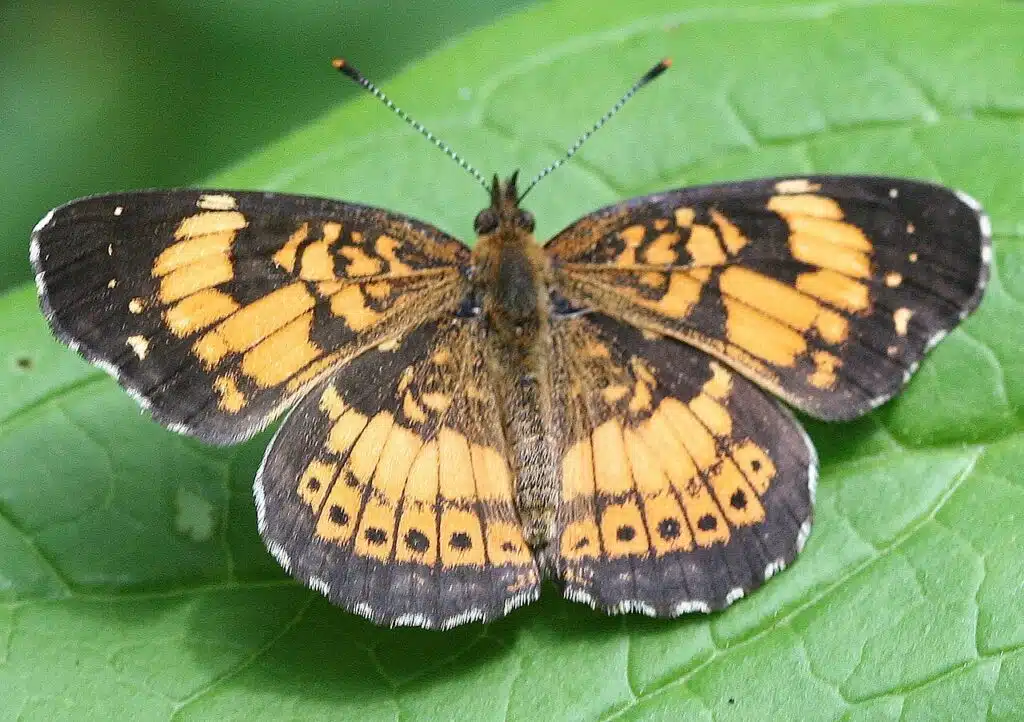
Silvery Checkerspot butterflies (Chlosyne nycteis) are only seen in June and July across the state.
These butterflies are found on asters in their caterpillar stage.
Adult Silvery Checkerspot butterflies feed on various plants for nectar.
Clover and milkweed are among the preferred nectar sources for the species.
35. Horace’s Duskywing
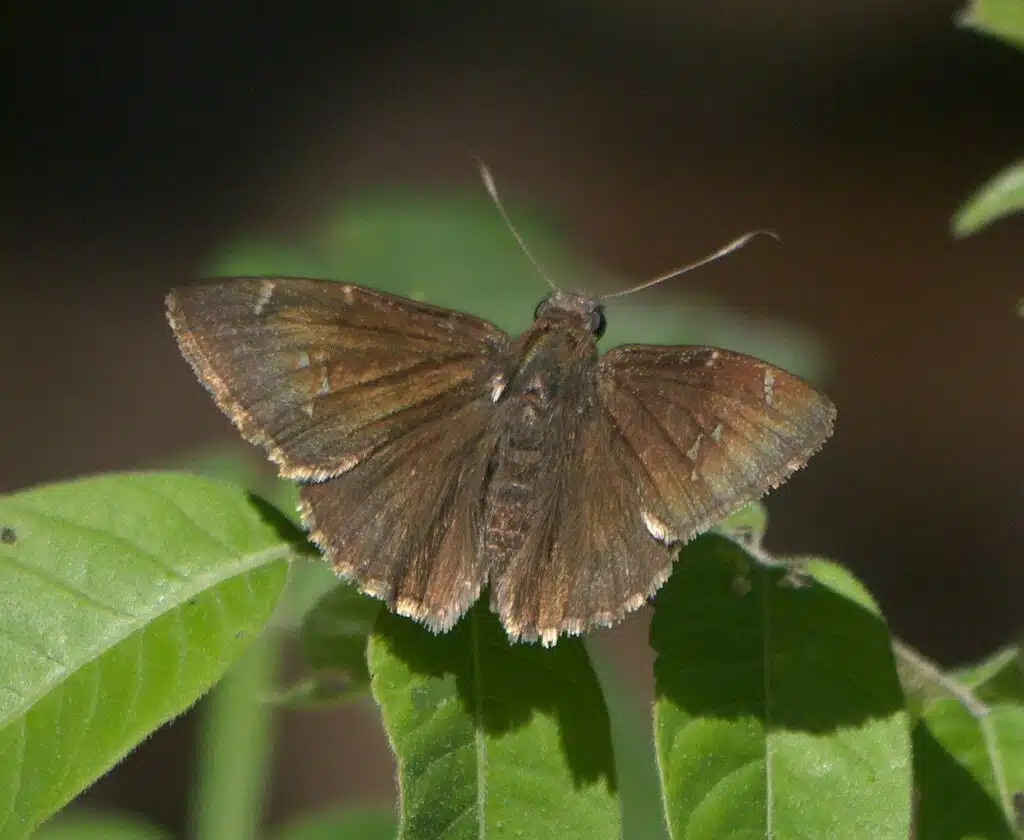
This species (Erynnis horatius) appears in 2 broods per year in Pennsylvania.
Brown and dark brown are the main colors seen across the dorsal side of Horace’s Duskywing butterflies.
You can find this species in open areas of woodlands and next to woodlands.
They feed on dogbane and similar other short flowers.
36. Little Glassywing
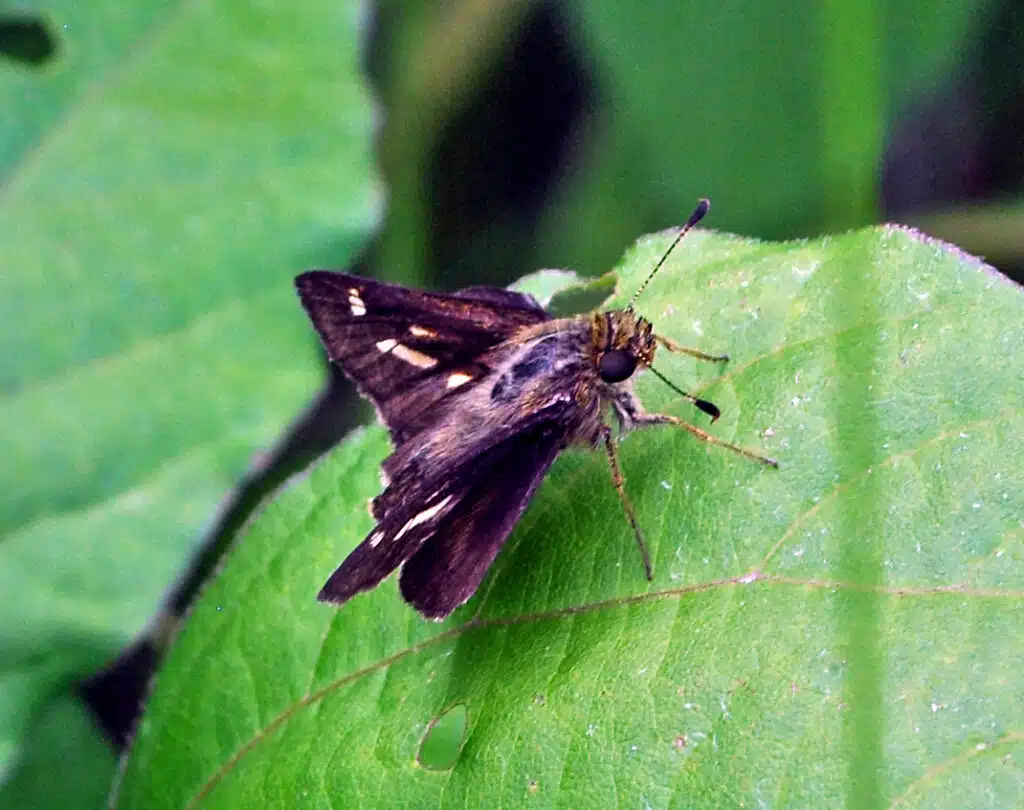
These types of butterflies (Vernia verna) are identified by a dark brown to almost black color.
They have a small to medium size with a wingspan that measures anywhere between 27 and 39mm.
The species is seen on colorful flowers and identified by its folded upper wings.
37. Common Wood-Nymph
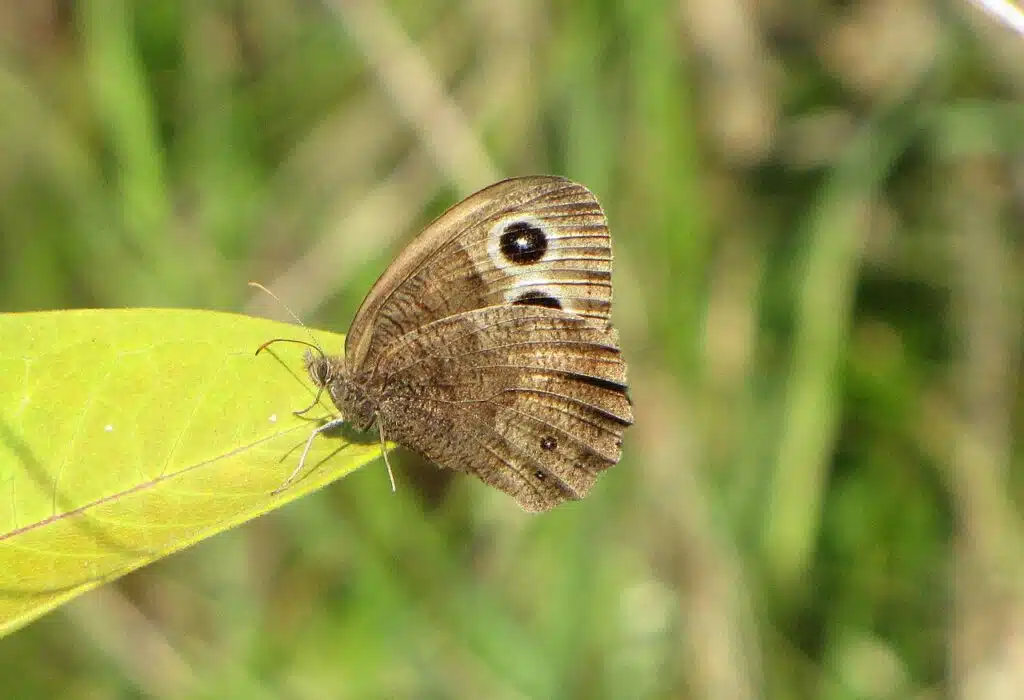
Dark brown dorsal wings and light brown ventral wings are specific to the Common Wood-Nymph (Cercyonis pegala).
A large yellow section is seen across the forewings of the species. These yellow patches are the areas where large eyespots are also distinguished on the wings.
Common Wood-Nymph butterflies are among the dominant small to medium-sized butterflies in the state with an expected wingspan of up to 2.9 inches.
38. Juvenal’s Duskywing
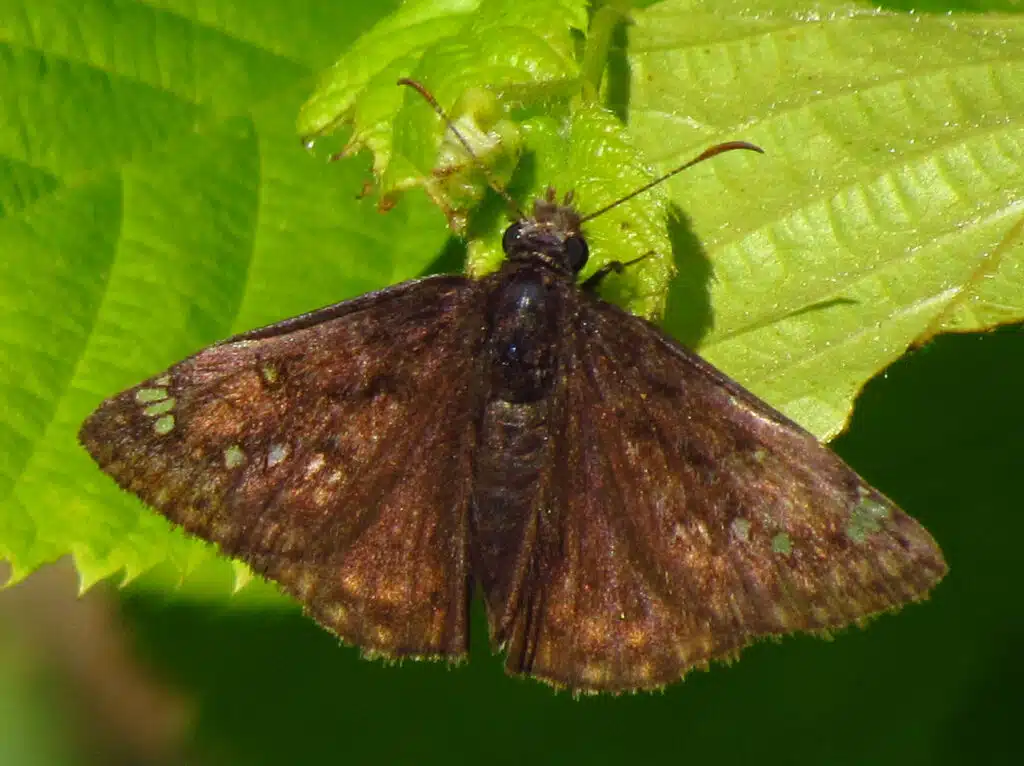
This species of butterfly (Erynnis juvenalis) looks almost black.
It has dark brown coloring with light brown patches across the wings.
Juvenal’s Duskywing butterflies have a wingspan of up to 37mm.
Small coloring differences are seen between males and females. The female Juvenal’s Duskywing butterfly has lighter brown nuances closer to gray.
39. Banded Hairstreak
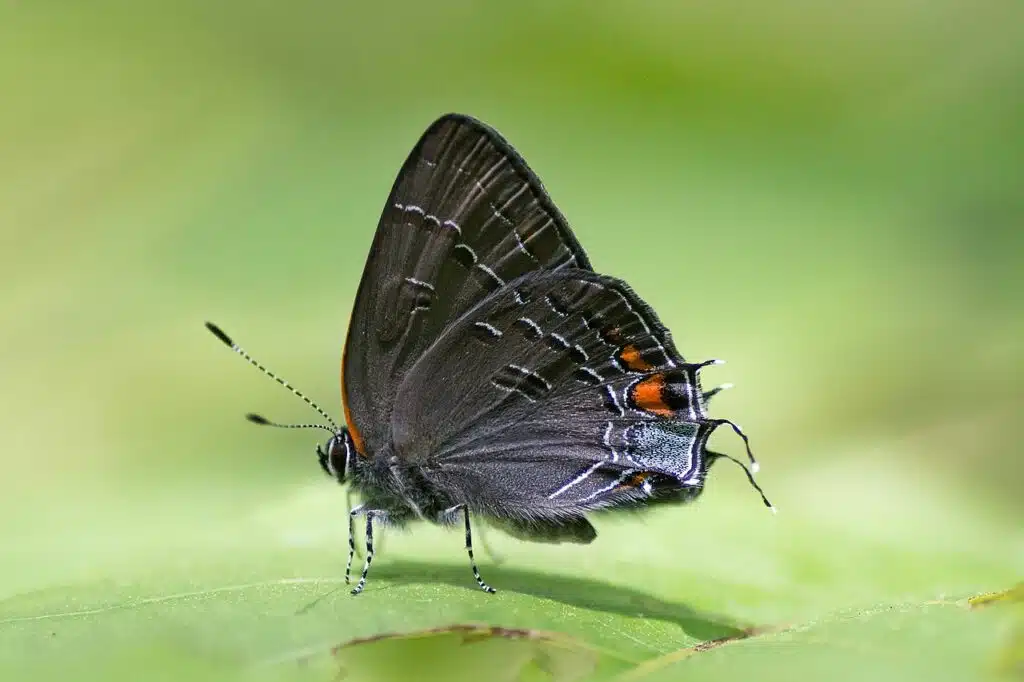
These light brown to gray butterflies (Satyrium calanus) are only seen in one brood per year, in the summer.
You can find Banded Hairstreak Butterflies along oak trees in the state in a caterpillar stage.
Adult butterflies of the species feed on dogbane and milkweed. Sweet clover is also a source of food for adult Banded Hairstreak.
40. Dun Skipper
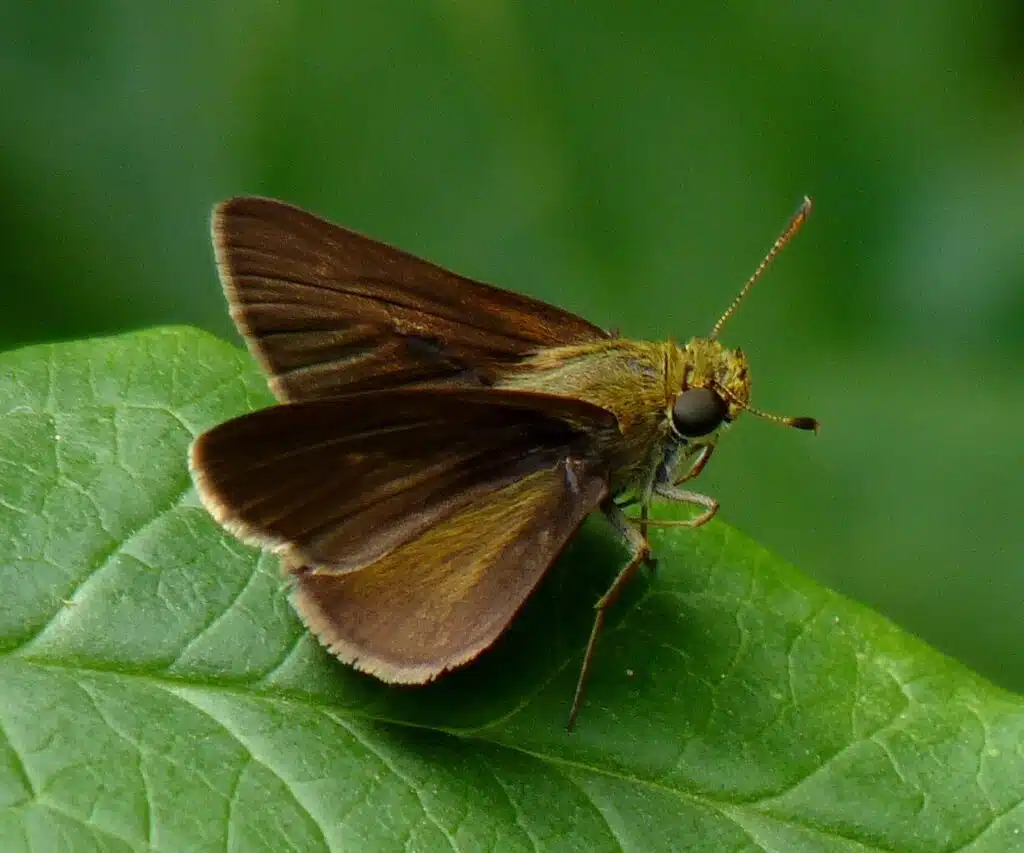
American vetch and peppermint are some of the most common food of Dun Skippers (Euphyes vestris).
Sedges are the host species of Dun Skipper caterpillars.
These brown butterflies have narrow white or off-white margins. They grow to a wingspan between 29 and 35mm.
Only one generation of Dun Skippers per year is specific to Pennsylvania. This species is first seen in July.